Boat Profile

The Crawford Melonseed Skiff
From a 19th-century gunning skiff to a classic sailer in fiberglass
From Issue Small Boats Annual 2022 March 2021
M any years ago, I was looking for a daysailer I could easily trailer, rig, and sail singlehanded. It had to look good, too, with some traditional aesthetics. Crawford Boat Building’s Melonseed Skiff fit the bill.
For over 30 years, Roger Crawford has been building his fiberglass version of the Melonseed Skiff in his small shop in Humarock, Massachusetts. He began when a decaying wooden boat, built to Chapelle’s lines in American Small Sailing Craft, was dropped off at his shop to be brought back to life . He restored the boat, took it sailing, and was so impressed that he wanted one of his own. He used the hull to make a mold he could build from, enlarged the cockpit, and increased the sail area. He has been busy building Melonseeds ever since, finishing them beautifully with teak rudder, tiller, rubrails, coaming, and floorboards, and varnished Douglas-fir spars. Anyone who has admired the lines in Chapelle’s book will recognize the low freeboard, hollow bow, curvaceous waterline, and enchanting tuck-up swooping from skeg to raked transom.
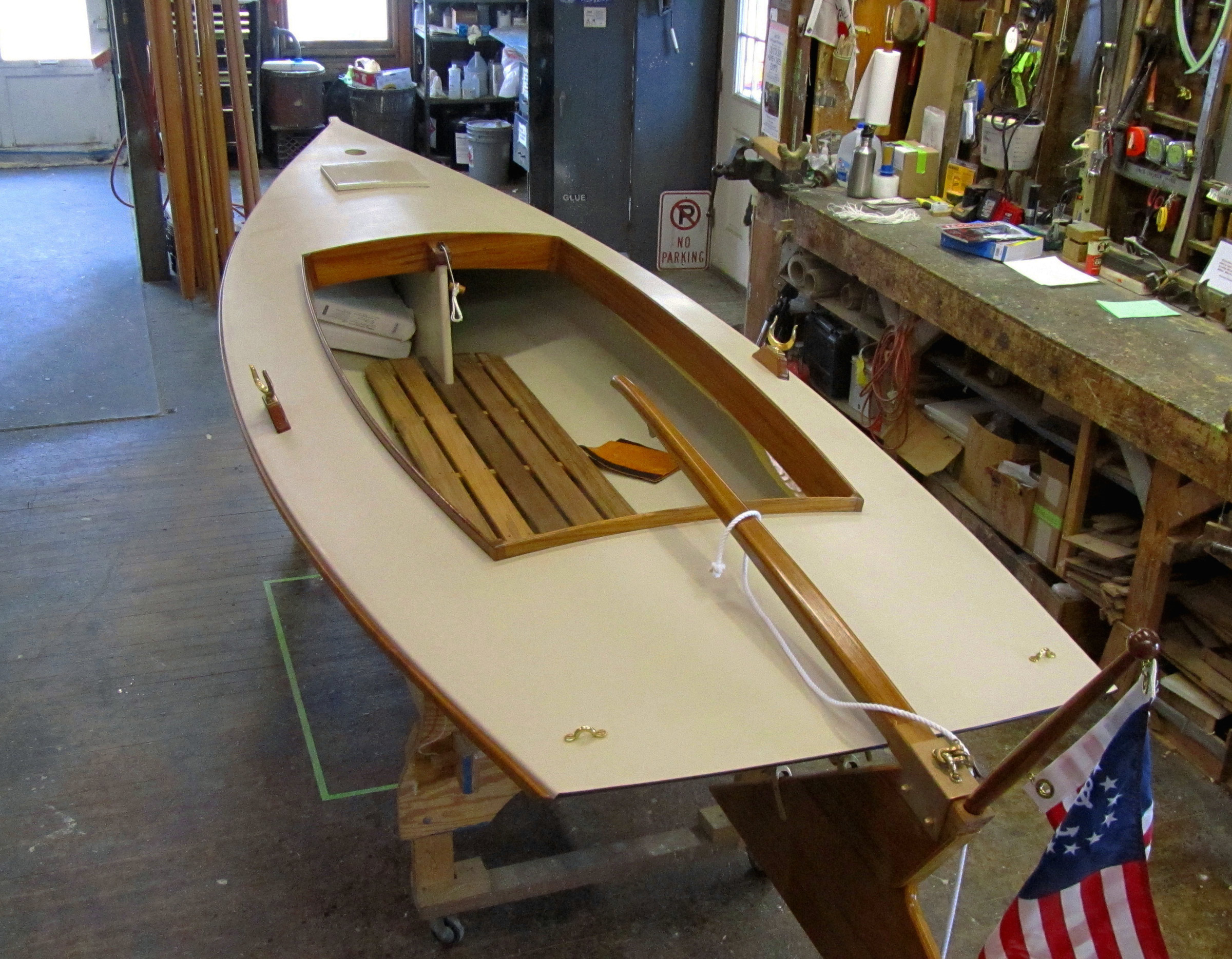
The spaces under the decks provide ample room for storing gear. A foredeck hatch facilitates access to items forward of the centerboard trunk.
Crawford builds his boats stout, with 1.5-oz mat, 0.5-oz mat, 32-oz stitched roving, and 10-oz cloth, doubled in the bottom, stem, and keel areas; the skeg receives 14 laminations. The deck is end-grain balsa core laminated between layers of 1.5-oz mat and biaxial stitched roving, with a nonskid finish that looks quite a lot like painted canvas. Solid fiberglass (without balsa core) in areas where there are through-deck fittings such as cleats, pad-eyes and oarlock sockets, assures peace of mind for years to come. The hull and deck are bonded together with epoxy, polyurethane adhesive, and stainless bolts and screws. Overlapped like the lid on a shoebox, the result is a strong, torsion-free unit.
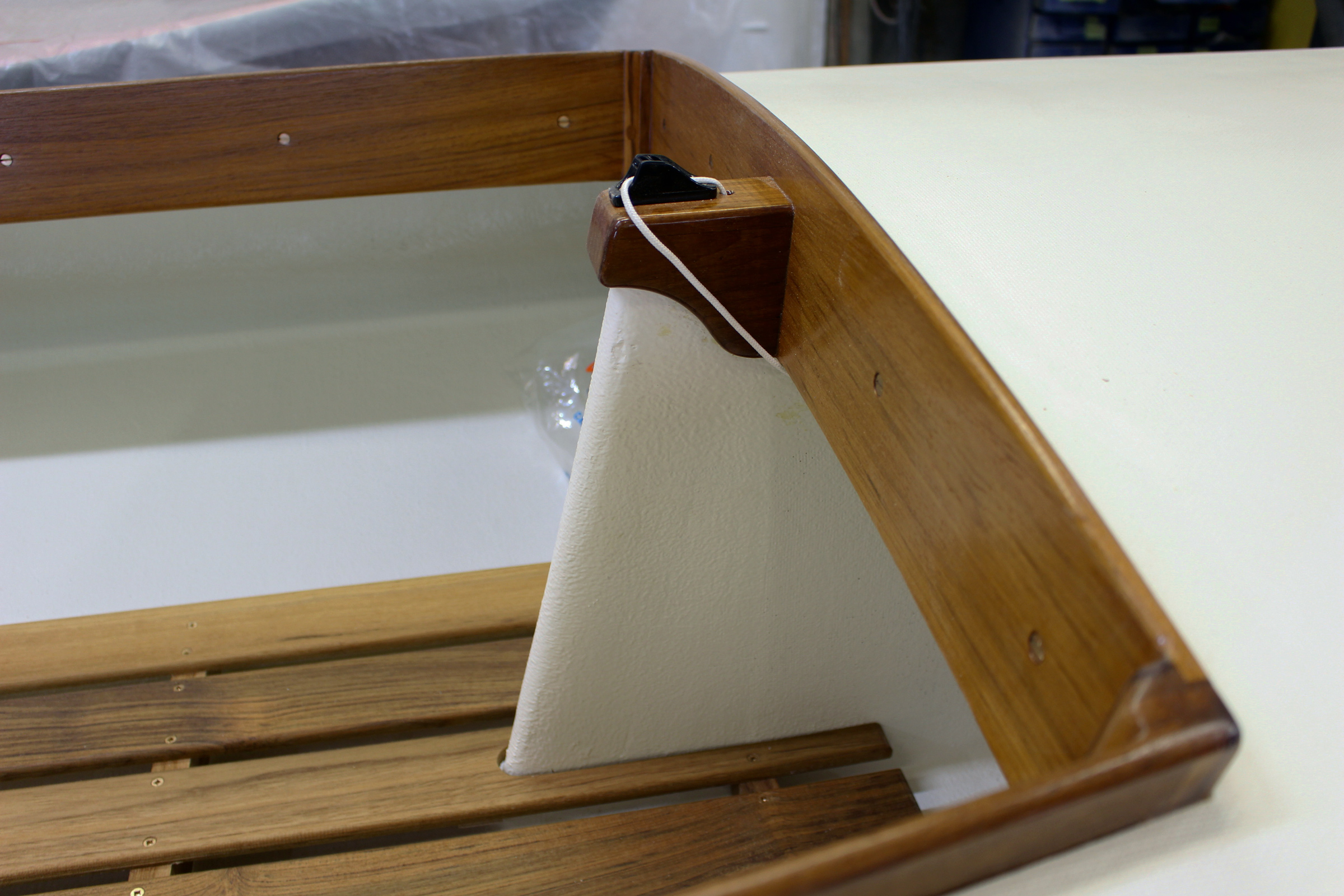
The PVC centerboard will lower itself with its own weight; a cord and a clam cleat will control its depth and allow it to retract upon striking an underwater obstruction.
Crawford built his first 99 boats with the traditional scimitar-shaped teak daggerboard as recorded by Chapelle. Starting with number 100, the boats have a 1/2″-thick PVC centerboard raised and lowered by a simple pennant. He engineered the centerboard to have sailing characteristics as nearly identical to the daggerboard as possible. I have owned and sailed both versions and find a negligible difference between the two. The daggerboard trunk is entirely forward of the cockpit, whereas the centerboard trunk, at deck level, intrudes into the cockpit about 4″, an acceptable trade-off for the convenience of a board that self-stores, pivots when grounding, and offers infinite adjustment.
The shallow hull with a barn-door rudder that does not extend below the skeg makes this boat well suited to the shallows, and with a 6″ draft with the centerboard up, one can glide and slide over some very skinny water indeed—perfect for creek crawling.
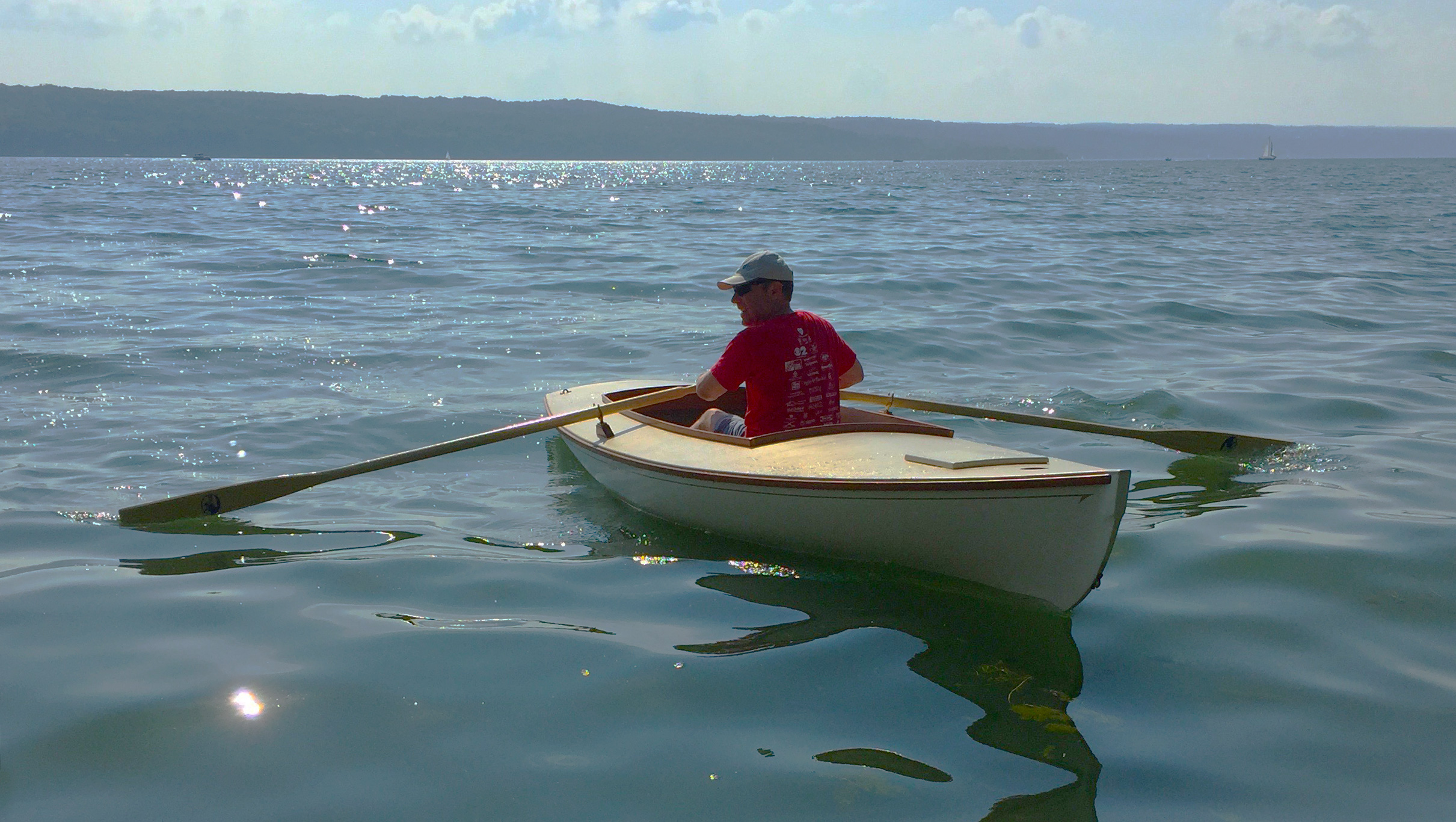
There isn’t a thwart for rowing, so a couple of boat cushions will get the rower into a comfortable position high enough off the floorboards. The sail and all three spars for the sailing rig can be stowed below deck when they’re not needed.
C rawford has taken great pains to keep the boat as simple as possible, which makes getting on the water an easy proposition. Rigging is straightforward and the free-standing rig makes getting underway quick. The sail is kept furled around the mast and together they weigh about 15 lbs. Stepping the mast is a simple matter of inserting it through the partner on deck and into the step below. Hang the rudder on the gudgeons, insert the tiller, and reeve the single-part sheet through the block on the rudderhead. Unfurl the 62-sq-ft sail and insert the sprit end into the becket at the peak and push up to spread the sail. Cleat off the snotter with enough tension to give a crease between tack and peak (it will disappear when the sail fills). Clip the sprit-boom snap hook to the clew and tension and cleat the boom snotter. It’s customary to rig the sprits on opposite sides of the sail so that the asymmetry averages out. The sprit boom seems to cut into the set of the sail more than the sprit, making the favored tack the one with the sprit boom to windward.
When you board, either from the dock or the shallows, step toward the center floorboards. The boat can feel a bit tiddly until the firm bilge submerges. Once you’re seated on the floorboards, the boat is very stable.
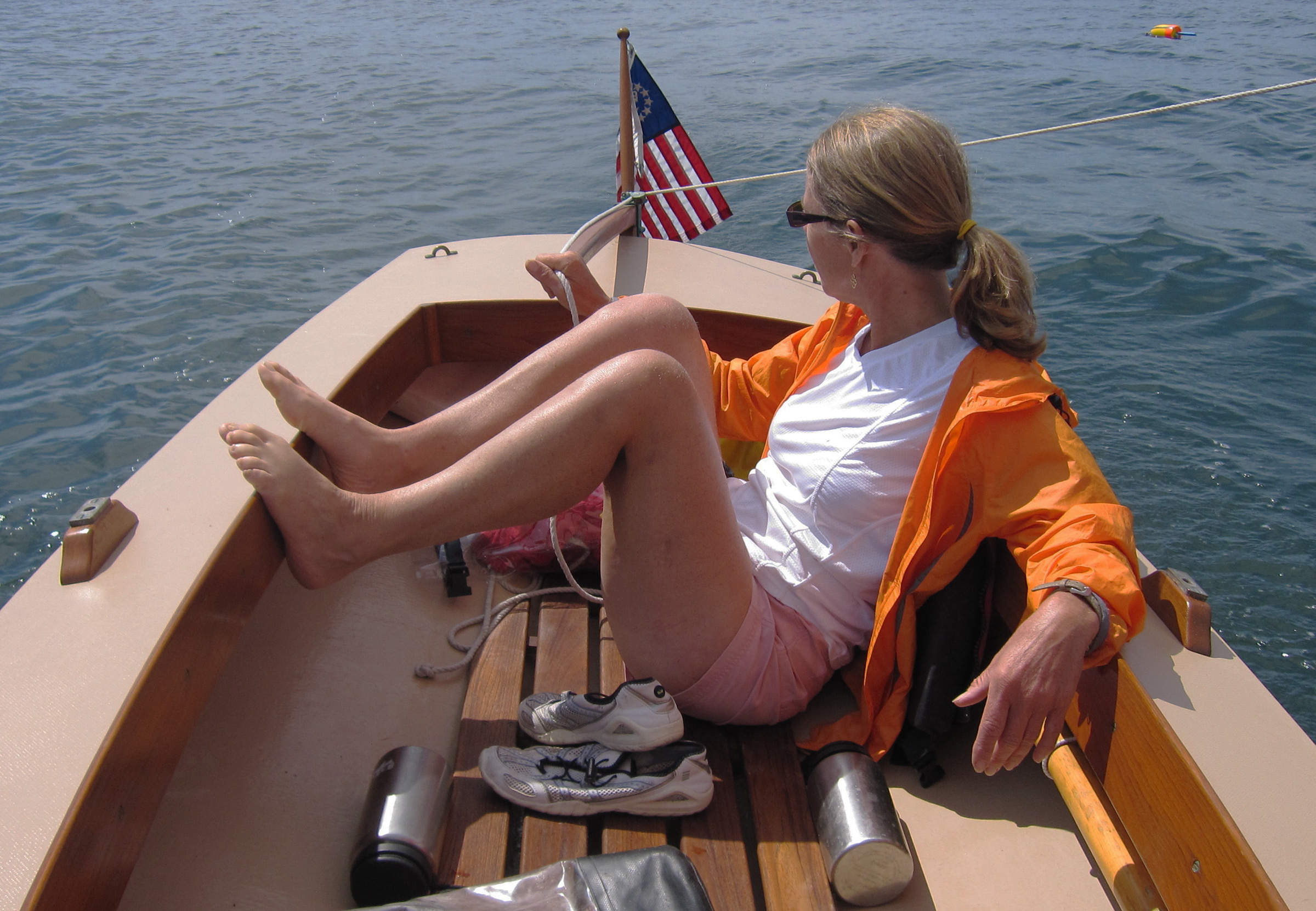
The sheet is lead forward from a block on the rudderhead so the sailor can steer and hold the sheet with one hand. A cleat under the tiller can hold the sheet when it’s safe to secure it.
I find the ideal trim for singlehanding is to sit about even with the oarlock sockets, adjusting fore or aft according to conditions. The tiller comes naturally under your hand. Those accustomed to mid-boom sheeting will quickly adapt to the sheet running forward from the block on the rudderhead to your hand.
Once in the cockpit, there’s little need for moving about, other than changing to the windward side when tacking. This is not a boat that you stand up and walk about on. It wants your weight low and inside the cockpit. Setting sail is most easily done on the beach or the dock because the hollow bow and fine lines make it skittish if you go forward on the deck. I have done so many times, to furl or set the sail, or re-tension the snotter, but it does require good balance. If going forward is necessary, it’s safest to sit or kneel on the deck. Another person sitting aft in the cockpit will keep the stern down and help to steady the motion.
The cockpit is a little over 6′ long—big enough for two people and a picnic. There’s room up under the deck for a cooler, anchor, and other gear, and a 10″ x 10″ hatch gives access to the forepeak. The 7 -1/2′ oars store under the side decks. At 5′ 9″, I fit comfortably with my back against the coaming and feet in the lee bilge, with the reassuring sense that I’m down in the boat, not on it. Because seating is on the floorboards, knees, hips, and lower back need to be supple enough to tolerate that position. When sailing with a crew, the usual arrangement is to sit on opposite sides, facing in. This balances the boat nicely in most weather. In stronger wind, both skipper and crew sit on the windward side of the cockpit. The boat is very responsive to trim and weight distribution, so adding the weight of the crew to windward makes the boat stand up well to more vigorous breezes.
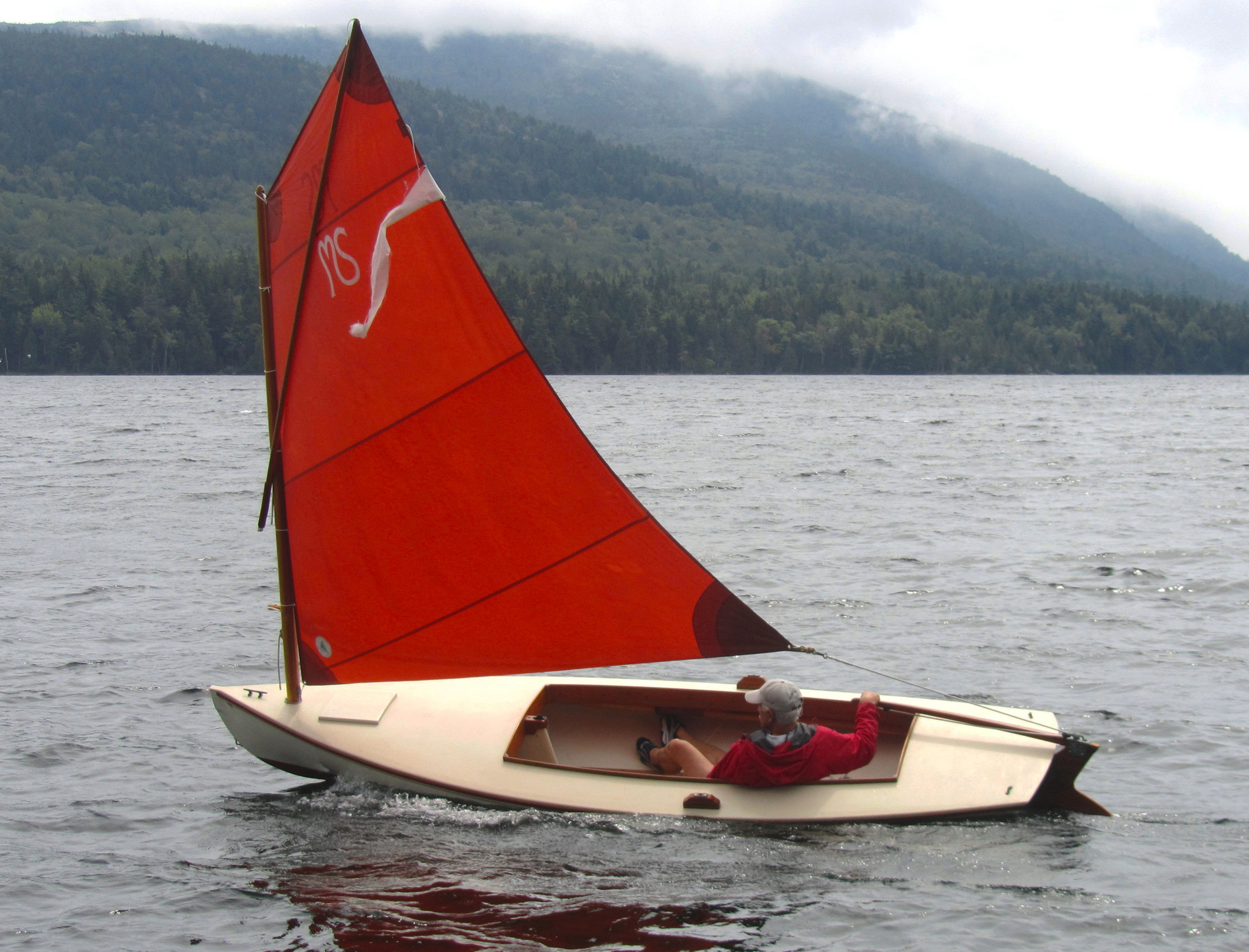
The Melonseed resists heeling well and often allows the sailor to sit on the downwind side in moderate breezes.
Despite the low-aspect, low-tech rig, the boat’s windward ability may surprise some folks. Although it doesn’t point like a Laser, it goes very well to weather. The spritsail doesn’t like to be strapped down too hard, and if it is, you’ll feel the stall. Give it a little room to breathe and the boat comes alive. It’s easy to find the sweet spot because the feedback from trim changes is immediate and obvious.
As the boat responds to a puff, the weather helm encourages it to head up, making it easy to naturally climb the lifts. Sailing fairly flat gives the best boat speed, but I find sitting out to windward in anything less than a Force 4 is unnecessary. In higher winds, sitting on the deck keeps the boat on its feet, reduces leeway, and maintains speed. When working to weather in a tie-your-hat-on breeze, you’ll need your foulies as spray sweeps the deck and cockpit and is tossed up into the sail. You’re plugged directly into the experience through the direct connection to sheet and tiller and the motion of the boat; the low freeboard and spray contribute to the sense of speed and adventure.
Because of the boat’s light weight, approximately 230 lbs all up, there’s little momentum to punch through steep chop hard on the wind. Easing the sheet and your course off the wind a bit will increase speed and deliver a palpable in-the-groove feeling. While it may require an extra couple of tacks, you will arrive at your windward goal far sooner than if you try to jam your way to weather.
When tacking, the natural weather helm does most of the work. I usually release the tiller with a slight nudge and let the rudder swing of its own accord. As the bow turns through the wind, I scoot over to the other side of the cockpit. By that time, the bow is falling on the new tack and I center the tiller and trim the sail. Coming about in a big chop requires that you sail through as opposed to relying on momentum to carry you.
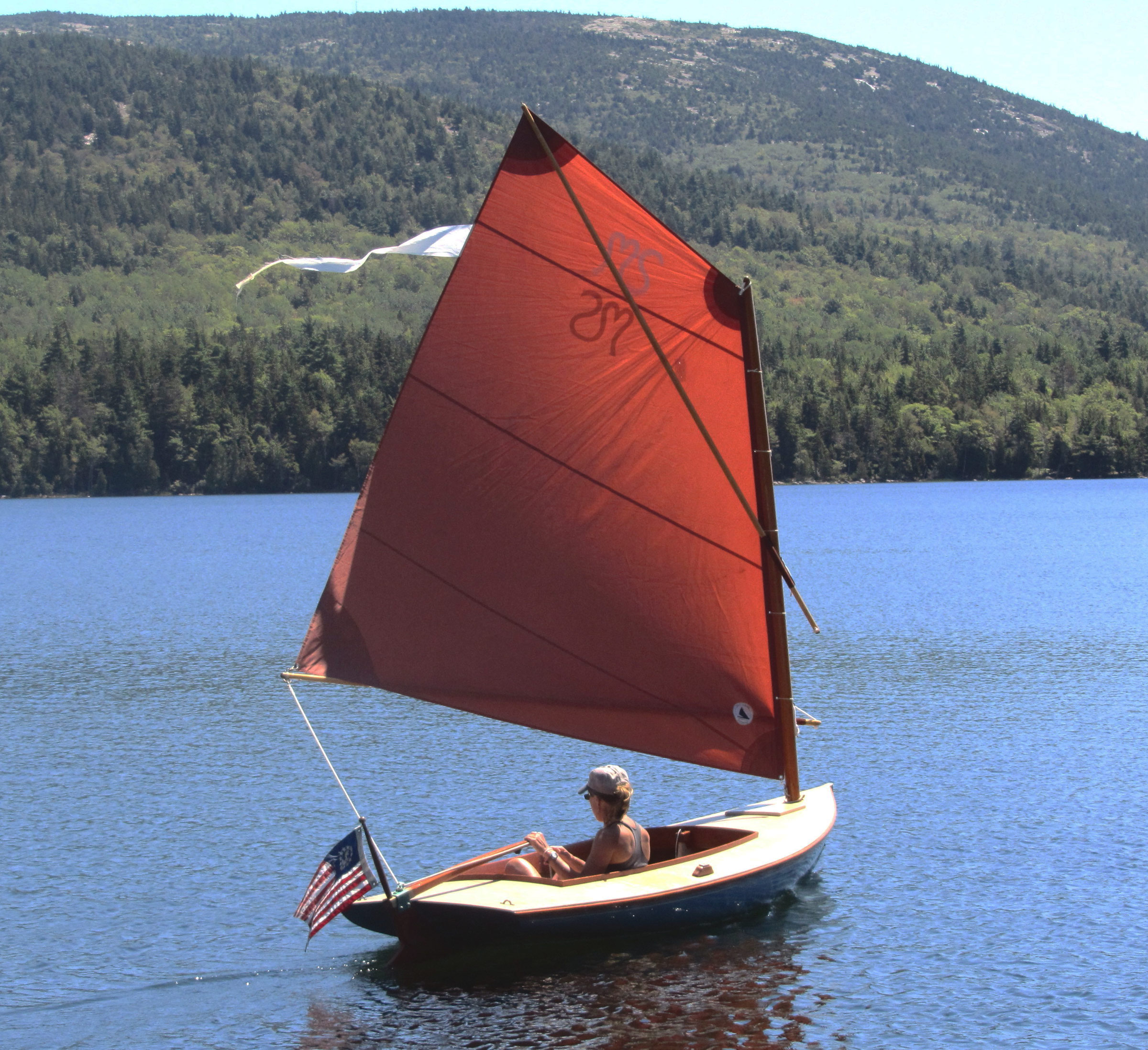
The sail is not equipped with reef points as most owners don’t find them necessary. When the breeze stiffens, the peak of the sail gets twisted to leeward, spilling the wind. The twist reduces the effective sail area and lowers the center of effort, reducing the heeling force.
If you get caught in irons, you won’t be there long. Because the mast is in the eyes of the boat, you can easily back the sail to swing the bow off. If you raise the centerboard and back the sail, the boat will pivot in place, a useful tactic when maneuvering in tight spots.
This boat will spoil you for jibing. The sprit-boom keeps the foot from rising and the single-part sheet runs smoothly through the block as you ease the sheet at the end of the jibe. Jibing is a casual affair in moderate conditions and doesn’t require much sheet tending. Higher winds demand more prudence and control. In Force-5 conditions, I opt for the “chicken jibe,” looping to windward to bring the boom across, then falling off on the opposite downwind tack. One of the benefits of the free-standing, rotating mast is that the sail can be luffed out forward of the mast to flag out ahead of the boat in certain situations, like easing into a lee shore landing in mild conditions.
Control downwind is good, as the sprit-boom exerts its self-vanging effect to limit the twist in the sail. There is, however, a golden rule: To prevent the white-knuckle “death roll,” don’t allow the peak to go farther forward than perpendicular to the boat’s centerline. Leaving a bit of centerboard down helps maintain directional control, and I usually scoot aft a trifle to give the rudder a little more bite. The tucked-up quarters and raked transom prevent the stern from dragging.
T he hull’s theoretical maximum speed for the 12’ waterline is 4.6 knots, and the boat seems to get up to hull speed easily. I can’t confirm this with GPS data, but I once sailed on one tack for 8 miles, closehauled, in a 12–15 mph breeze. I loosely timed the leg, and the resultant math showed a bit over 4 knots, which I thought impressive for sailing closehauled into a chop. The boat really struts its stuff on a reach, with the bow wave bubbling along the side deck. In the right conditions running before the wind, it’ll plane for short distances, and sometimes surf down the backs of the waves.
Crawford’s early boats were equipped with reef points. Reefing can be done, but it requires rigging a halyard and longer snotters which complicates the simple setup. In those early years, Crawford decided that the reefpoints were superfluous because the boat is so capable in such a wide range of wind speeds. No one was using them anyway. In reality, if you think the boat needs a reef, you probably shouldn’t be out there. Scandalizing the sail by dropping the sprit and letting the peak of the sail fold over is useful in a hard chance, but pointing ability will be compromised.
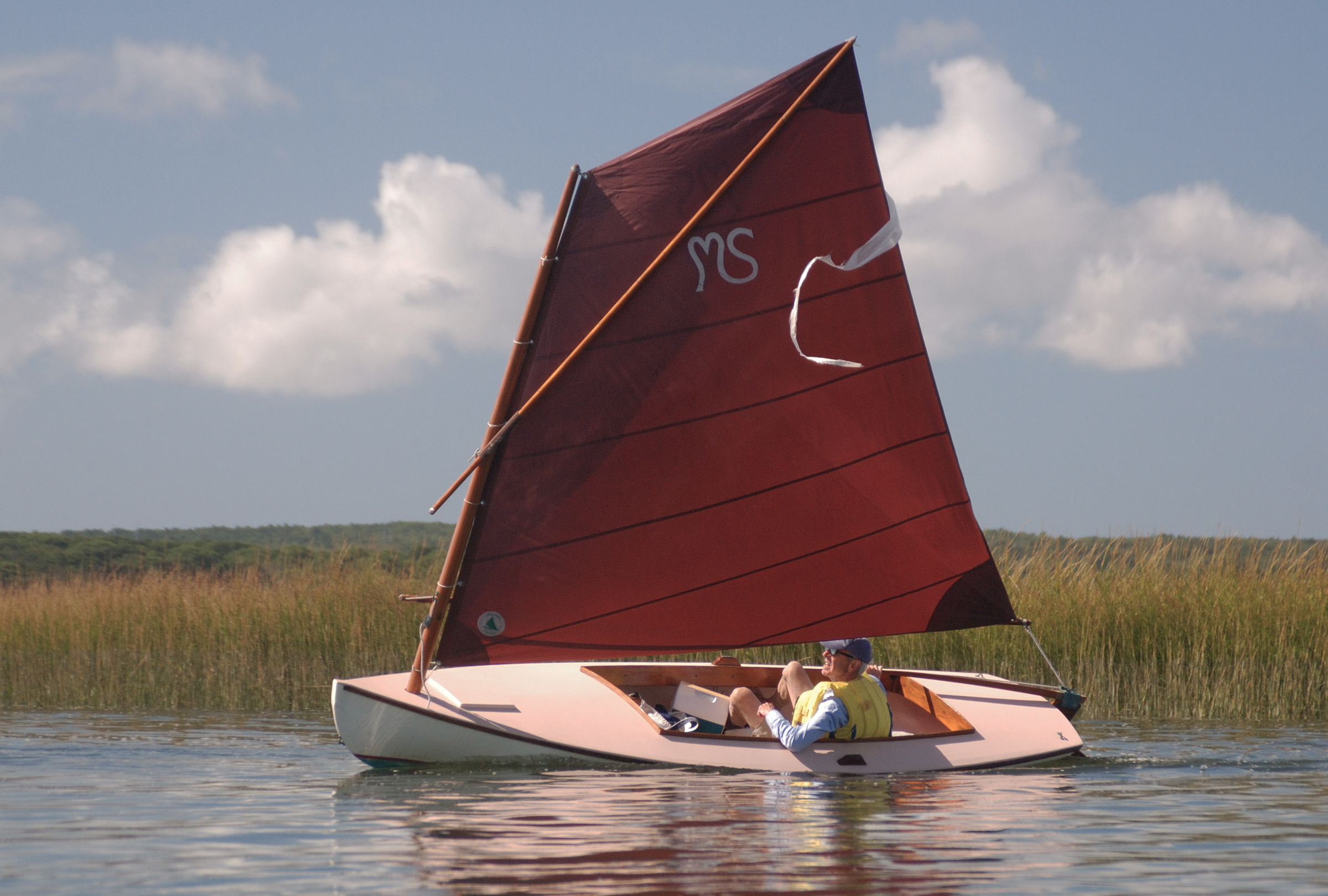
The 62 sq ft sail has enough area to provide pleasant sailing in light air. The spars are Douglas-fir and the trim, tiller, and rudder are all teak.
A 10–15-mph breeze is magic, but the Melonseed will ghost in a whisper and tromp happily to windward throwing spray in 20. I have sailed in mid- to high-20s with gusts over 30 and the boat took it in stride.
Capsizes are rare, and all I know of were caused by a cleated sheet that wasn’t freed quickly enough in a gust. The small clam cleat on the tiller can be used to relieve your grip on the sheet, but the sheet should stay in hand in all but the mildest breeze, cleated or not. The full bilges do a good job of resisting heeling once submerged, and the peak of the sail tends to depower as it twists off a bit in the bigger puffs. Solid water creaming alongside the coaming is your cue to ease off. But there is a point of no return, when solid water over the coaming fills the cockpit and you wish you had eased the sheet. The boat has flotation under the decks and will float upright when swamped.
On those days when the breeze is elusive, I “power-sail” through the flat spots with a few strokes of the leeward oar. It’s also possible to row off a lee shore in moderate conditions with the sail set. You can leave the sheet unclipped to allow the sail to luff without the chance of it wrapping around the tiller. Be prepared for the foot of the sail to take a swipe at your hat.
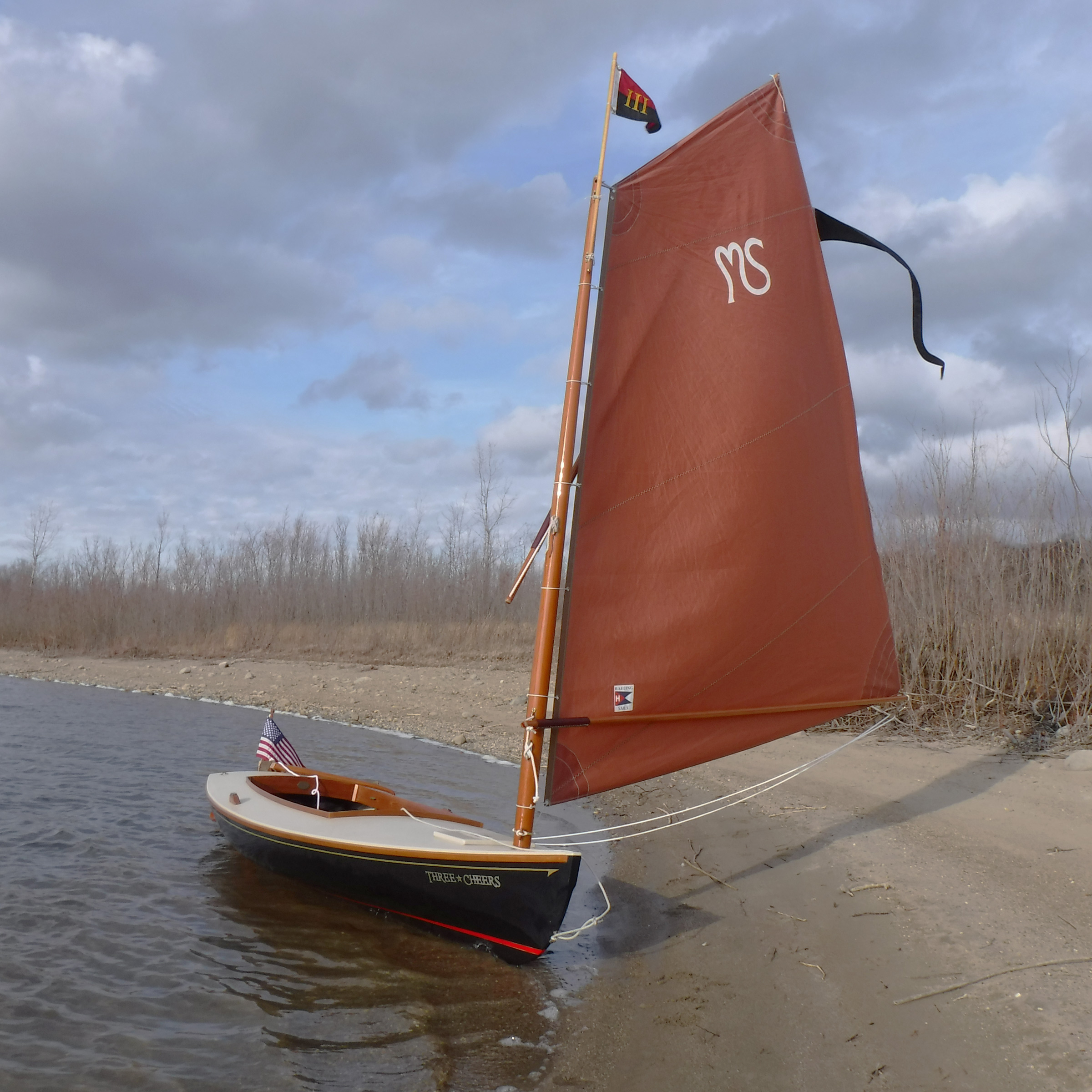
The boom and the sprit are set on opposite sides to even out their effect on port and starboard tacks. THREE CHEERS, shown here, is the author’s Melonseed, hull #463 .
Although you can row with the rig struck down inside the boat—the 10′ spars fit entirely under the decks—I prefer to leave the rig ashore if I’m rowing just for the pleasure of it. The boat carries well between strokes, tracks well, and isn’t knocked off course by a cross-chop. There is no thwart—sitting on a couple of cushions puts me at the right height. Crawford has an optional foot brace that bolts to the floorboards with wing nuts and can be positioned specifically to suit the rower.
Since I keep the boat in the garage and haul it to the water for each sail, ease of trailering is an important consideration. With the spars stowed in the boat alongside the centerboard trunk, the Melonseed makes a neat, streamlined package for towing. The boat and trailer total less than 500 lbs, so it’s an easy pull even for a compact car.
Roger Rodibaugh, despite living in landlocked central Indiana, has been sailing for 50 years. He credits the sailboat on top of his first birthday cake with starting it all. He recently retired from chiropractic practice and sails his Crawford Melonseed Skiff, THREE CHEERS, on Summit Lake and Prairie Creek Reservoir. He’s looking forward to the sailing season of 2021, which will be his 30th in a Melonseed.
Melonseed Skiff Particulars
Length: 13′ 8″ Beam: 4′ 3″ Displacement: 235 lbs Sail area: 62 sq ft Cockpit length: 6′ 1″ Spar length: all 10′ Weight: 235 lbs
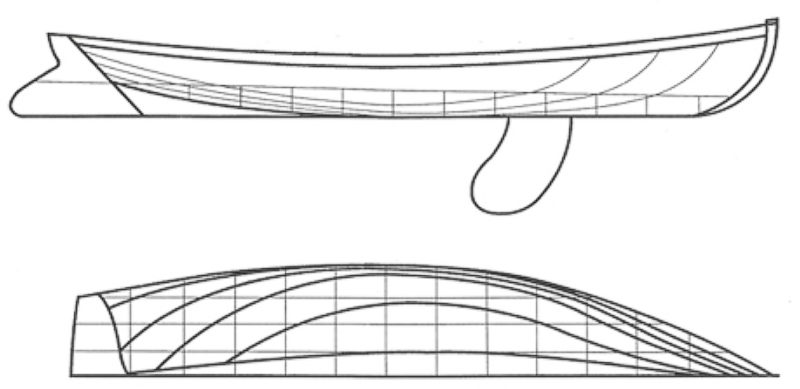
Finished Melonseed Skiffs , complete with standard equipment, are available from Crawford Boat Building for $15,500. (Prices updated March 2022)
Is there a boat you’d like to know more about? Have you built one that you think other Small Boats Magazine readers would enjoy? Please email us!
Share this article
Join The Conversation
We welcome your comments about this article. If you’d like to include a photo or a video with your comment, please email the file or link.
Comments (8)
For one of the very best of all the Melonseed videos open this link . Turn up the volume as the music is wonderful, pour a glass of your favorite beverage and watch some beautiful sailing.
Perhaps the best of the small traditional craft for recreation. Few have survived and I suspect that most of the Jersey gunners used the cheaper sneakboxes. The Seaford skiffs of Great South Bay on Long Island seem to have been more common, are shaped about the same but have a built down keel and are centerboarders, instead of the sprung keel and daggerboards of Melonseeds and sneakboxes.
Folks – with all due respect to the long time Melonheads on the eastern seaboard and others far and wide; you have just heard from the Master of the Midwest Melonheads, a group of fun-loving kindred spirits that ‘RJR’ as we call him, started gathering together back in 1999 (I think it was) for a week long gathering known as the Melonseed Midwest Rendezvous or MSMR as we’ve called it. It is truly a blast and we look forward to it every summer – well except this past one. RJR will shy away from this designation, but I believe he has done more to celebrate and promote this wonderful sailing craft than any other, short of Roger Crawford himself. For some of the most evocative video of the Melonseed you’ll ever see, check out John Masella’s YouTube channel .
And for a glimpse of RJR’s familiarity with this wonderful little skiff, check out the bit from my 2013 MSMR vid starting at about 2:05:
I’m blessed to have taken my first ride in RJR’s Melonseed in 2001 and then went home and ordered up a boat. Try one and you may do the same!
Doc Musekamp Oshkosh, WI MS#178, Pearl
Great article, RJR! Informative with a beautiful layout. Along with Roger Crawford’s website, it’s my new link to send to folks I’m trying to convert to a Melonseed.
This is the Way.
Holly Bird Palm Harbor, FL MS#268, GOSHAWK
Your wonderful article on the Crawford Melonseed was a cruel reminder that it is still March in New England and still a bit early to get back on the water in my Melonseed! Instead I went out to the garage to give it an admiring look and a pat on the gunnel. Digger Donahue BOLD O’DONAHUE Hull #534
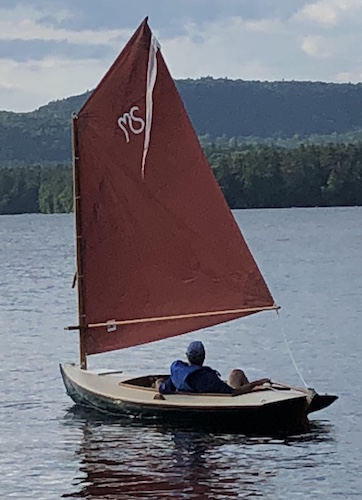
Digger, there’s a lot to be said for having your little darlin’ in the garage where you can give her a look and an affectionate pat—day or night and in all weathers. My Melonseed lives in the garage and the daily view has gotten me through many, many winters and fanned the flames of anticipation for the new season. Wishing you an early and long season on the water. RJR
Beautiful lines on this Crawford Melonseed. I very much enjoyed the article and the video of the boat in action! Thank you.
My Melonseed, SERENITY, (#241) is a joy to sail. It really doesn’t get any better than this.
Leave a Reply Cancel reply
Your email address will not be published. Required fields are marked *
Stay On Course
More From This Issue
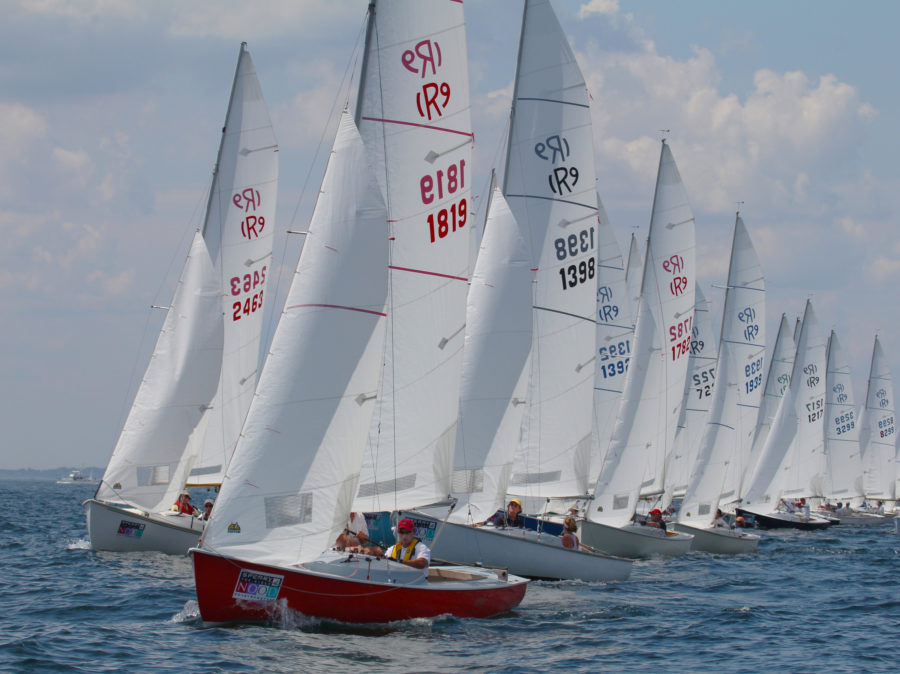
The Rhodes 19
Facing rising materials costs and a poor economy, O’Day had discontinued production of the Rhodes 19 by 1980. That could have been the end of the class, but its officers…
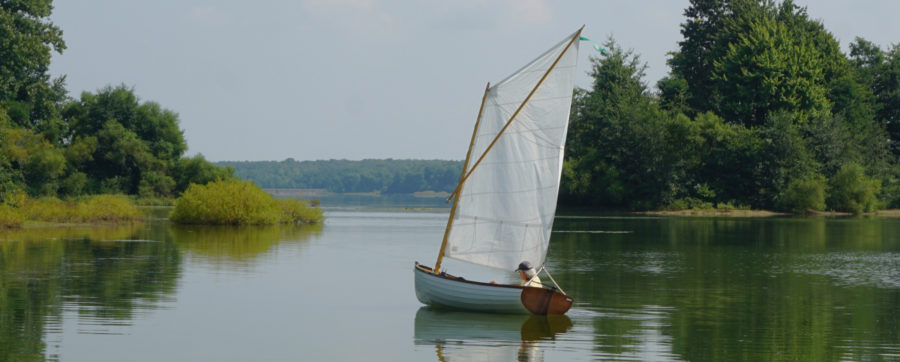
The plans for the Ellen from Brooks Boat Designs are on 12 sheets and include full-sized patterns for the molds, transom, rudder, and other parts. No lofting is required. The…
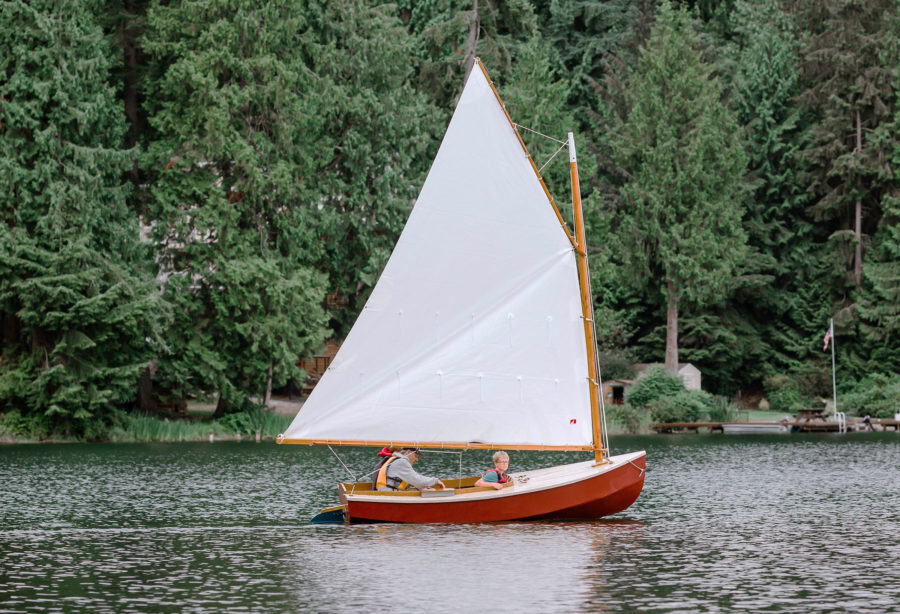
The barn-door rudder is 24″ long, 16″ tall, and 1-1/2″ thick. I made mine of three layers of 1/2″ ply. Its bottom edge is even with that of the skeg…
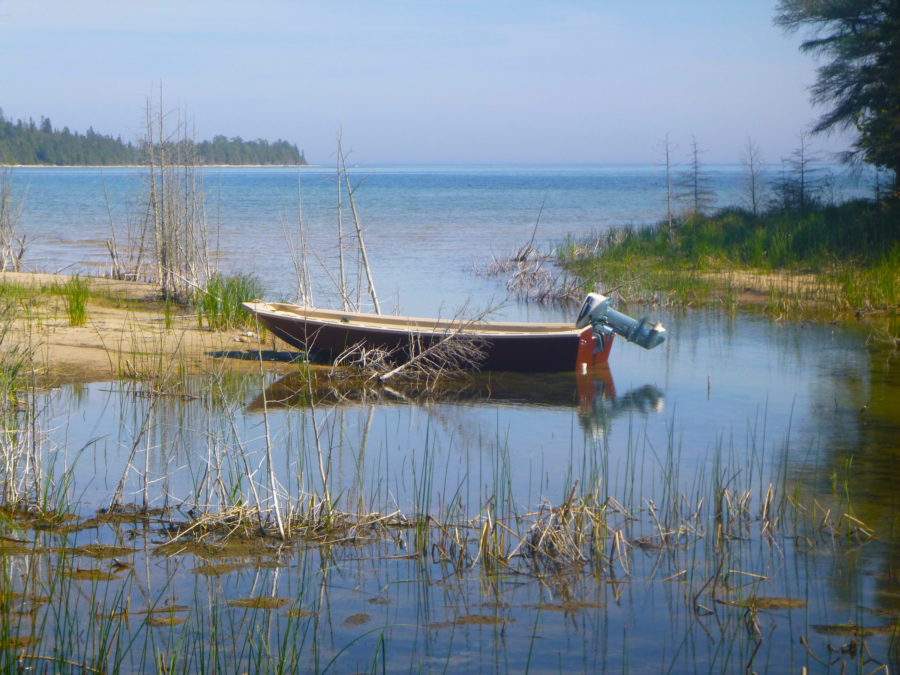
Sponge Docks Skiff 13
When I happened across the Sponge Docks Skiff 13 by Bedard Yacht Design, I was immediately intrigued by the simple, practical interior and the gently curving sheer and transom sides.…
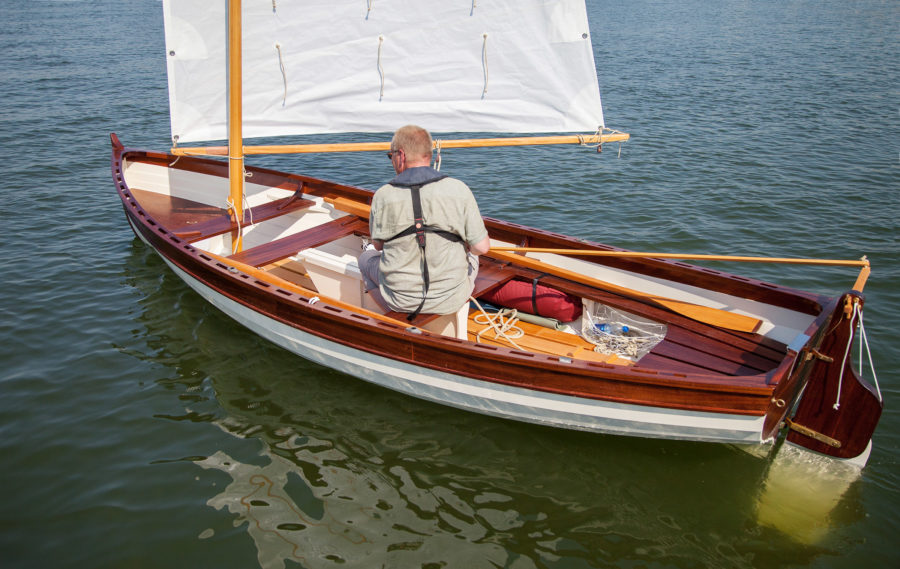
I have been impressed by the solid feel and stability of Penny Fee. Lightly loaded, the transom is well clear of the water, promising good load-carrying capabilities without added drag.…
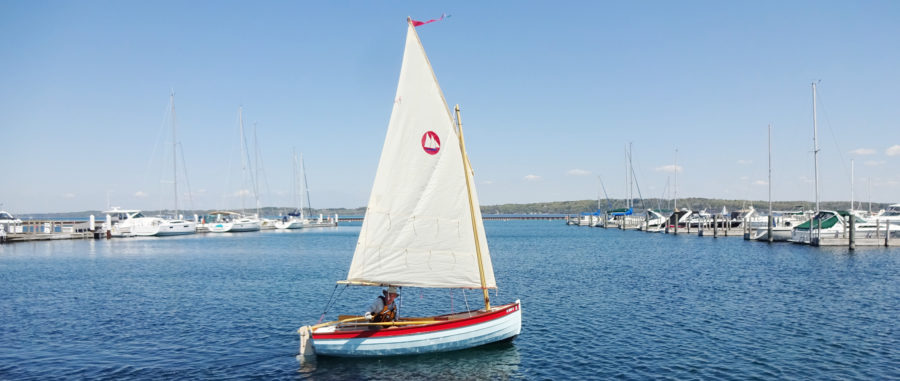
rance’s rugged Atlantic coastline is a popular and challenging cruising ground, but it was not so long ago that countless fleets of small workboats called its remote harbors and rocky...
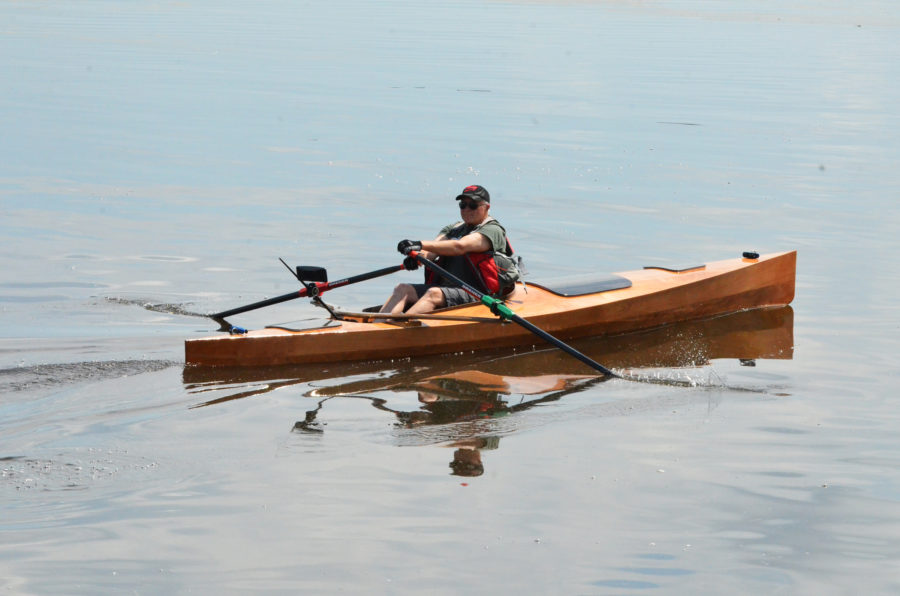
Expedition Rowboat from Angus
fter 20 years spent building, then sailing our beloved 38′ ketch, a Herreshoff Nereia, on the Great Lakes and St. Lawrence River, there came a point when Louise and I...
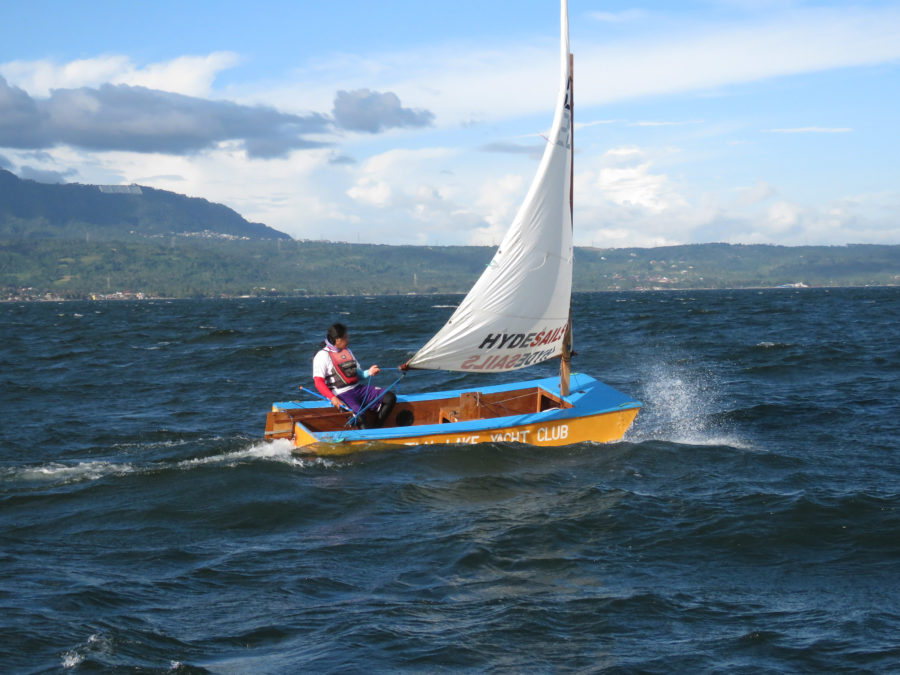
In light winds, you might normally sit well forward while going upwind, but with the Goose, the square bow needs to be out of the water or you will be…
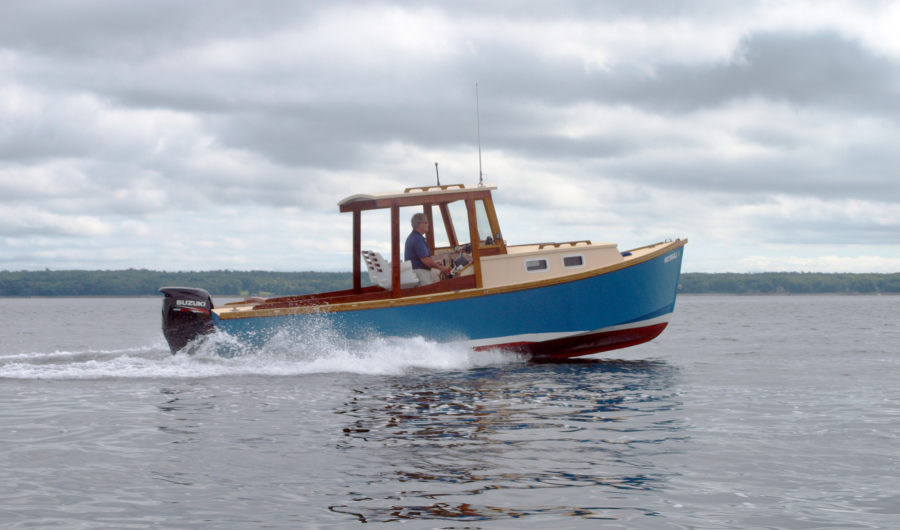
The JiffyV-22 is 22′ 6″ long, has a beam of 8′ 6″, and draws just under 2′. With its cabin, it is reminiscent of classic Maine lobsterboats, and is designed…
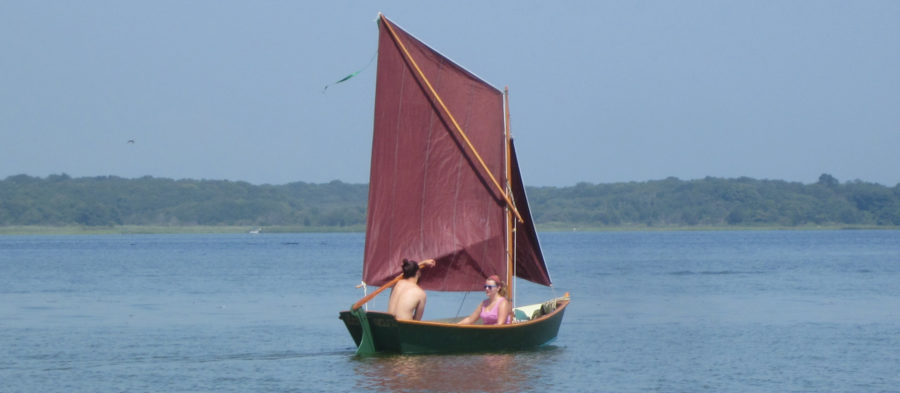
Conrad Natzio originally designed the 14′ Sandpiper for a workshop and demonstration at the Boat ’99 show in the United Kingdom. The first four of these attractive little sailing and…
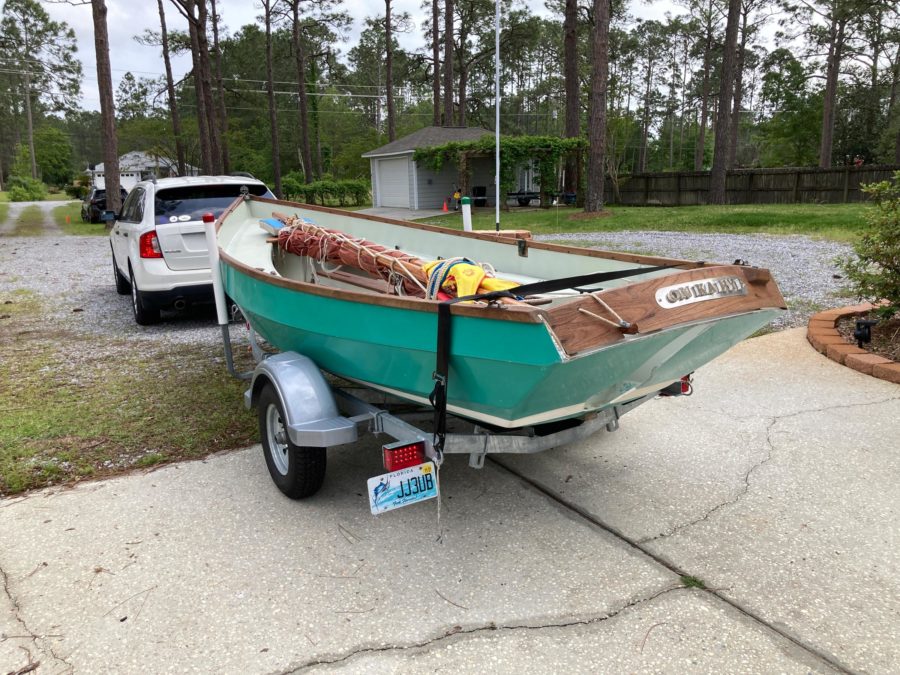
Boat Trailering Tips
To deal with breakdowns on our long-range trips, we carry a grease gun, rags, either a spare set of grease-packed bearings or a hub with bearings already installed, along with…
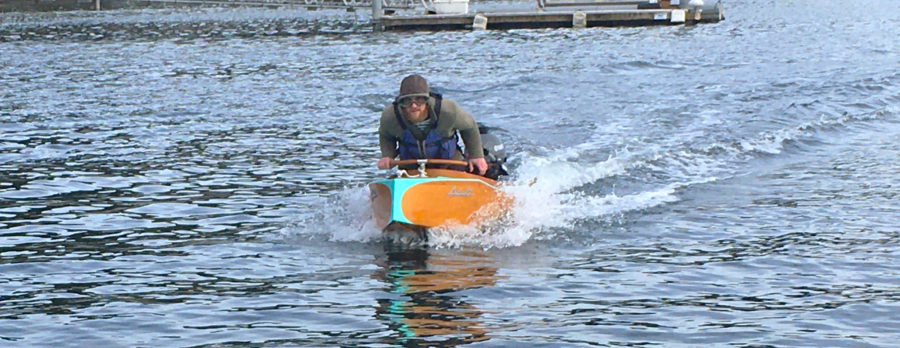
Reader Built Boats
He started with a wedge shape for the hull: a plumb stem to part waves and a flat run for planing. As he explored the shape with a model of…
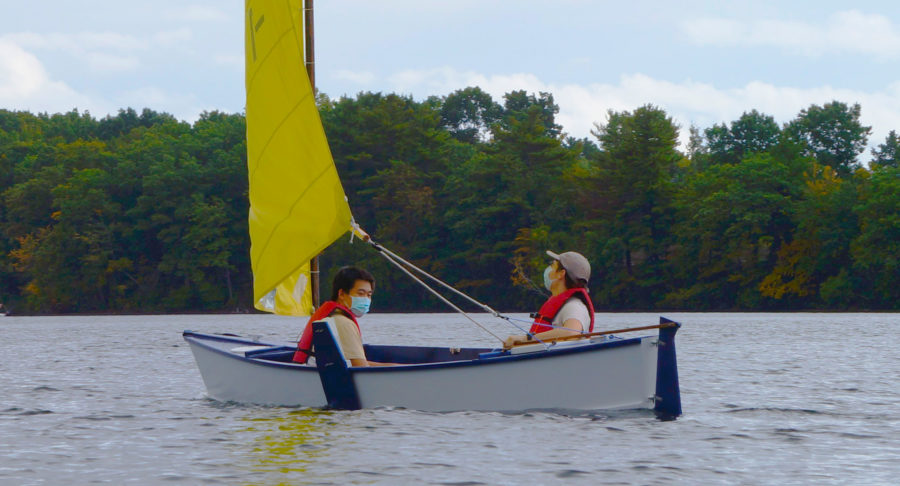
Surf Crabskiff
The hull is designed for simplified chine-log construction, which eliminates the necessity for a strongback or jig. All the plywood parts except the rudder fit onto just four 4′ x…
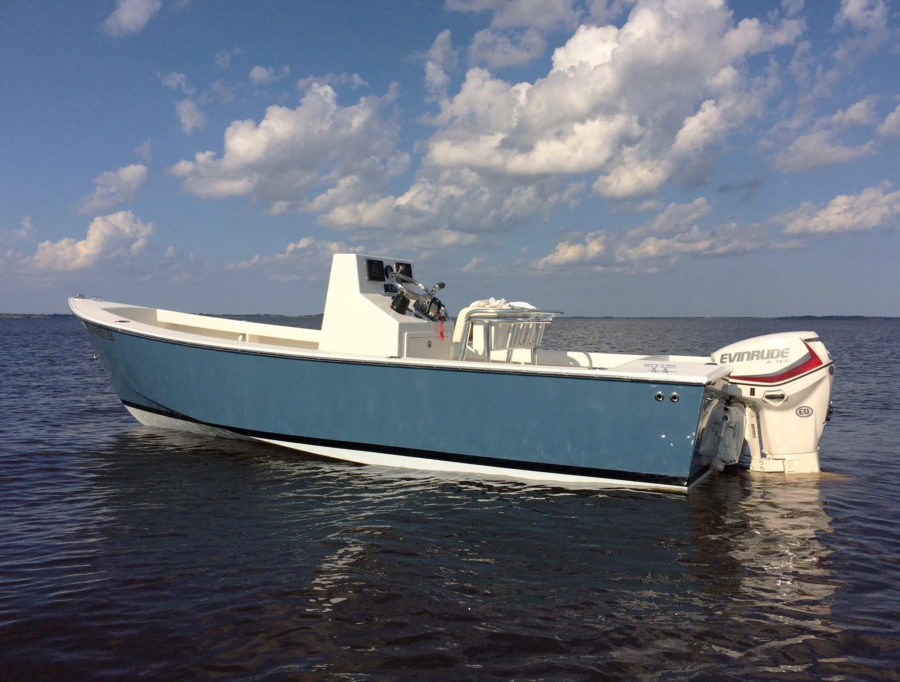
The boat handles beautifully in most anything I’m comfortable taking on in an 18’ boat. It turns exceptionally well when I’m cruising winding rivers, and on hard turns at speed…
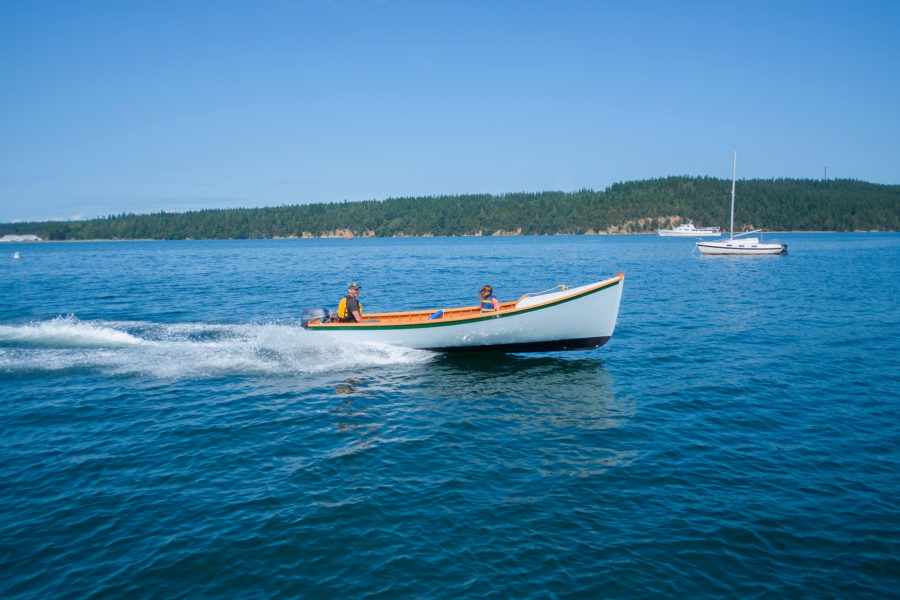
Down East Workboat
Gardner drew the design in 1981, basing it on old photographs and measurements of an 18′ workboat from Washington County, Maine. He described the design as a double wedge, the…
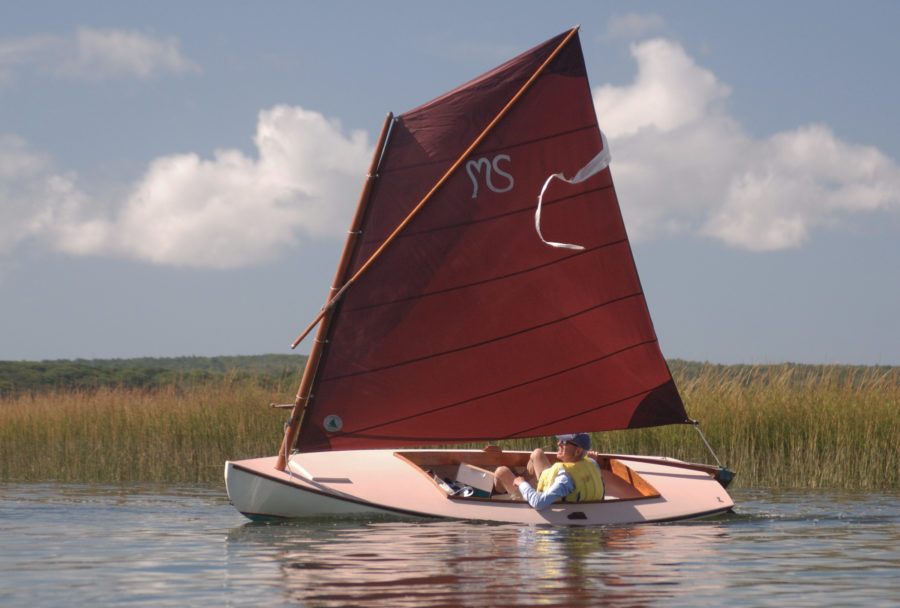
The cockpit is a little over 6′ long—big enough for two people and a picnic. There’s room up under the deck for a cooler, anchor, and other gear, and a…
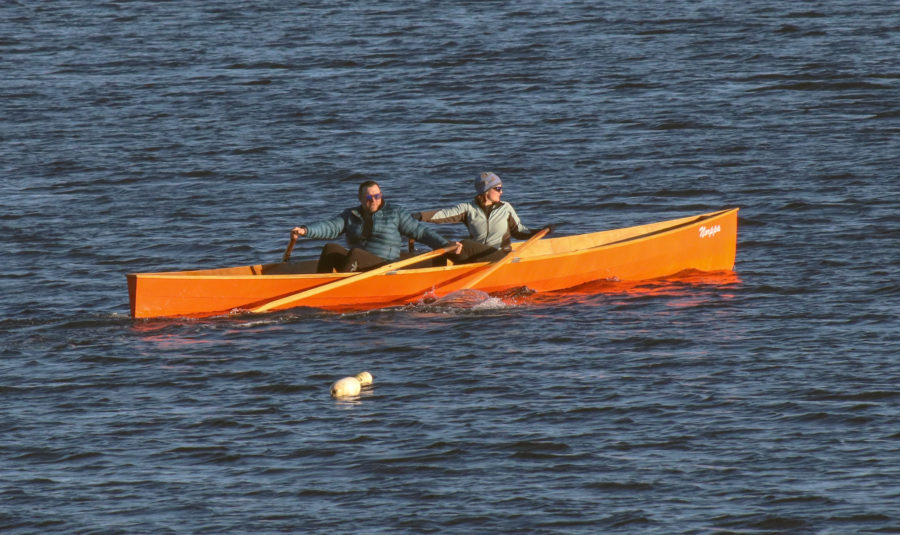
Designed to be light, the Savo 650D’s keelson, gunwales, and frames are made of pine or spruce. The fully equipped boat weighs in at just over 100 lbs. The length…
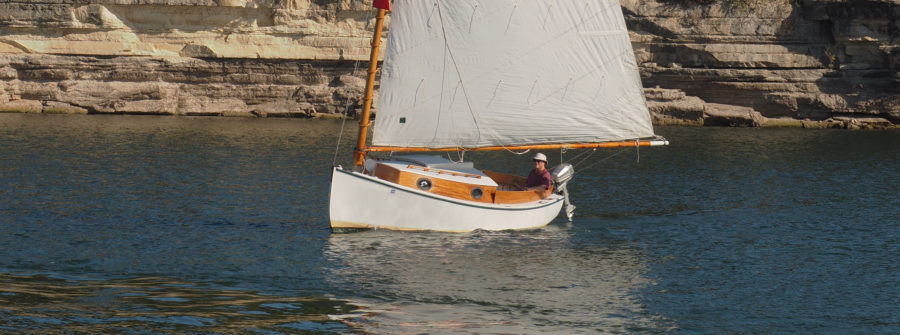
The Wittholz Catboat
The plans for the 17′ 1″ plywood catboat include 11 sheets with good construction detail: materials, dimensions, fastening schedules, notes, and comments. Several alternatives are included: self-bailer instead of deep…
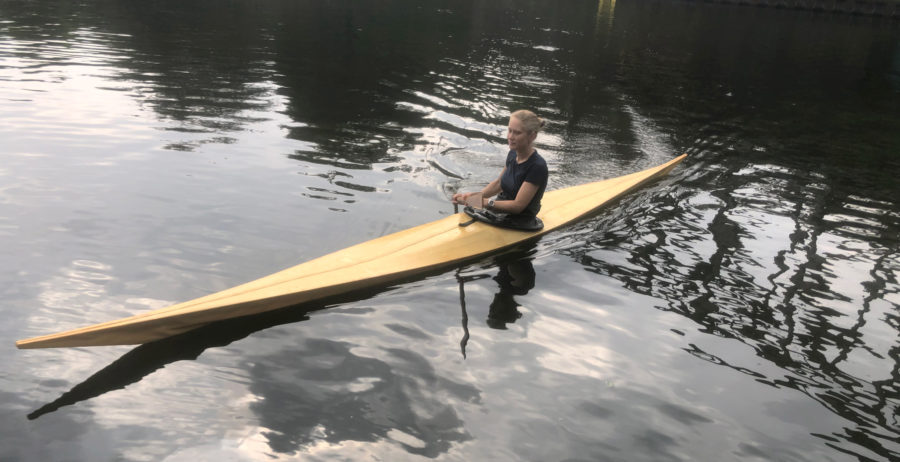
Don’t Tell Me I Can’t
“A little too big” came back to me as I stood in a lumberyard collecting the first of the materials for building a Greenland skin-on-frame kayak, but the echoes of…
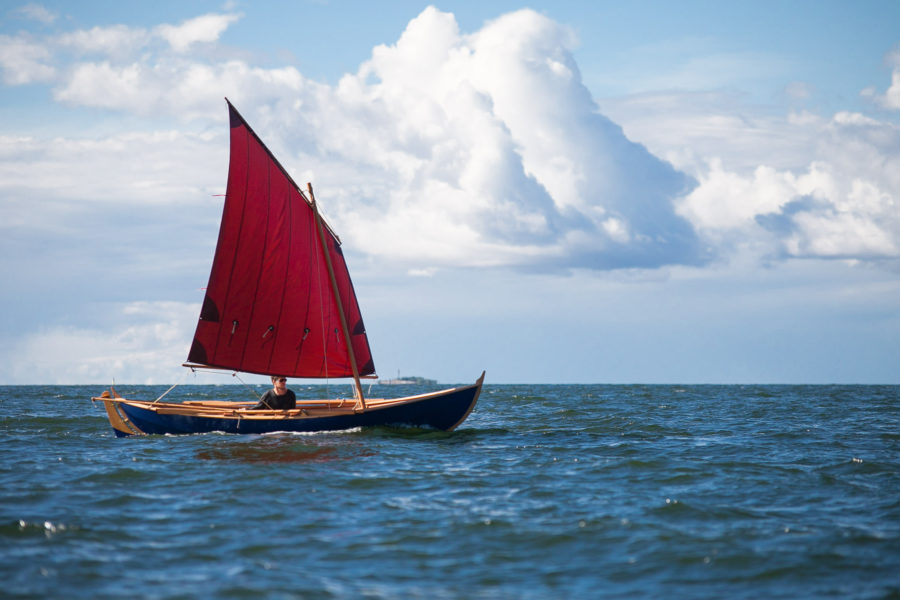
Elfyn sails very well without the daggerboard, even tacking into the wind. When returning to our launch ramp against a light headwind, I raised the daggerboard and Elfyn kept on…
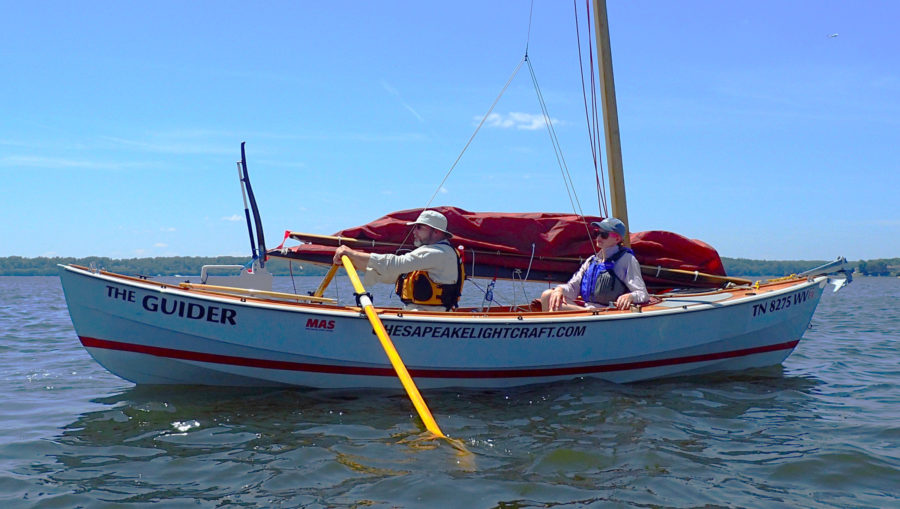
In a word, my overall impression of the boat’s performance under way was: “Easy.” With 300 lbs of crew (my daughter and myself) and 200 lbs of foam-wrapped lead ballast…
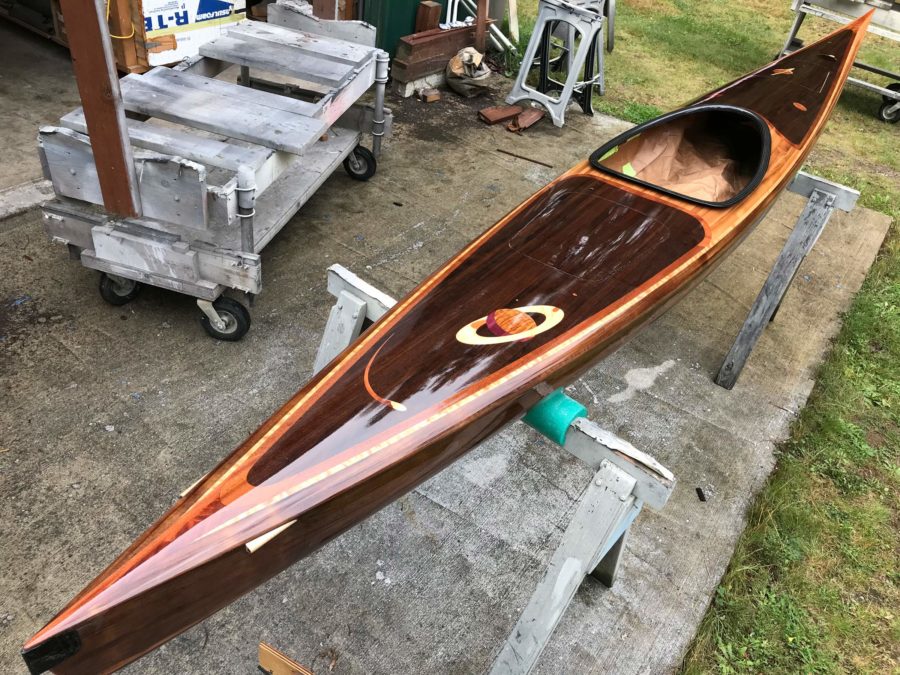
Dan has been drawing, painting, and sculpting for the better part of his life and has an artist’s eye. He recalls, “I got to thinking that wood could be an…
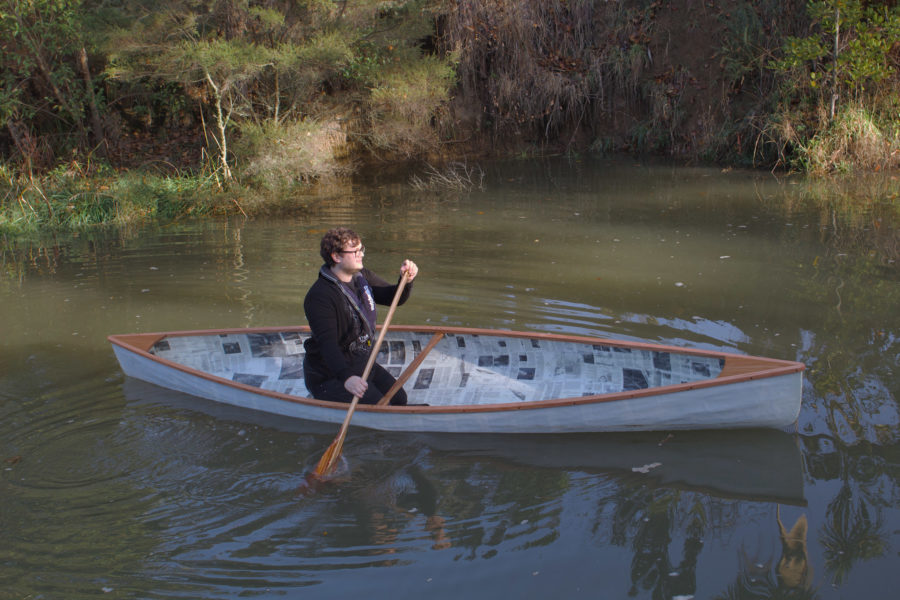
Built by the Book
The lockdown in New Zealand began on March 23 and David stayed home to do his part in slowing the spread of COVID-19. He focused on his canoe projects and…
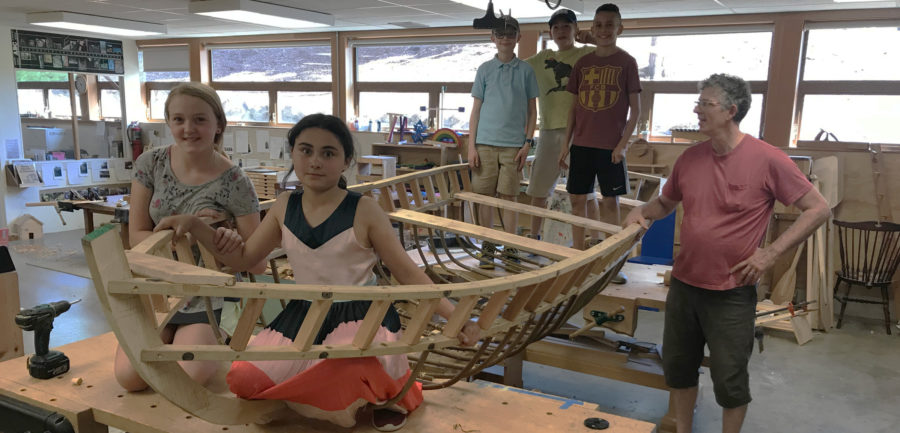
A Kid-Built Curragh
In 2019, Ric took on a more ambitious project, a currach, with his fourth and fifth graders. The frame of their version of the traditional Irish rowing boat, built without…
More Boat Profile
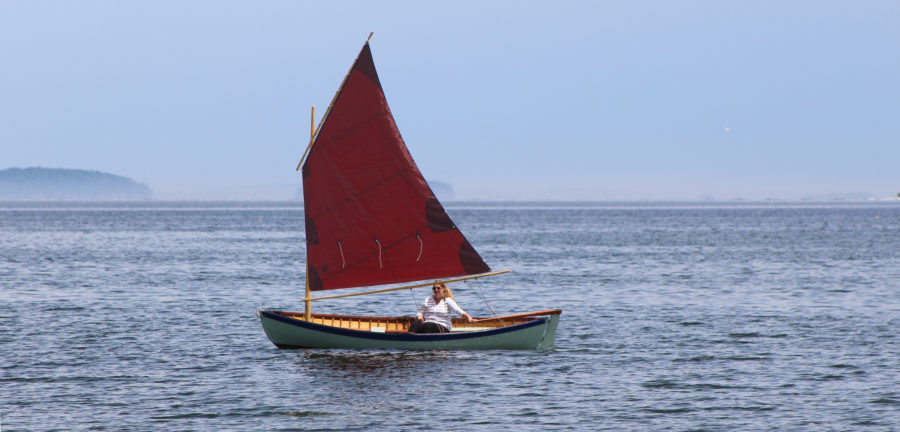
Maine Coast Peapod
The peapod might be one of the most easily identifiable, traditional small craft found on the coast of Maine today. Peapods were used as nearshore lobstering boats; a lobsterman could…
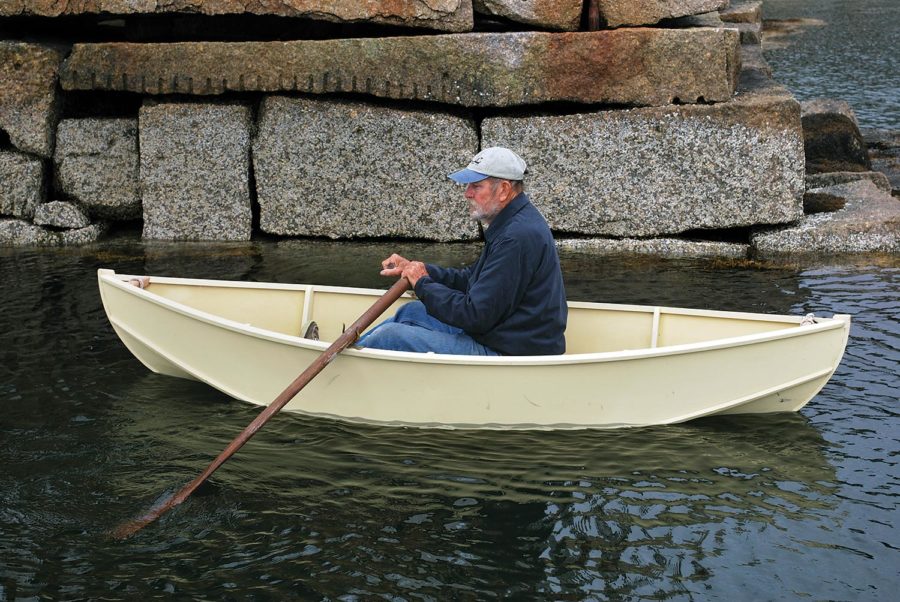
The McIntosh Canvas Boat
Canvas sheathing over a wooden framework makes Ned McIntosh’s 9’ dinghy extraordinarily light, at only 35 lbs, yet it remains a versatile tender that is easy and quick to build.
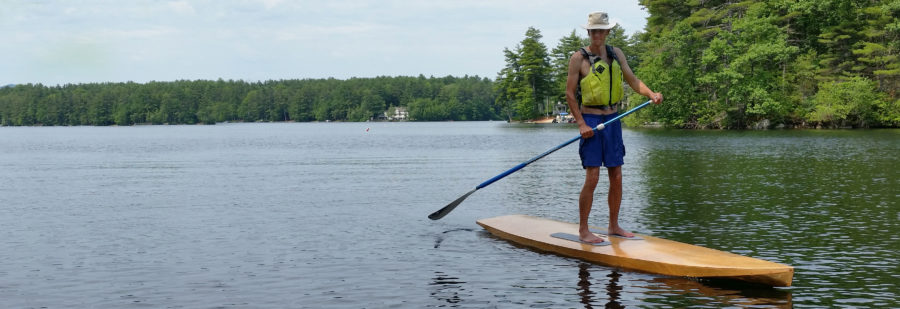
Australian-born designer Michael Storer developed a wooden SUP and named it Taal after a lake near his home in the Philippines. The boats and canoes he designs are light yet…
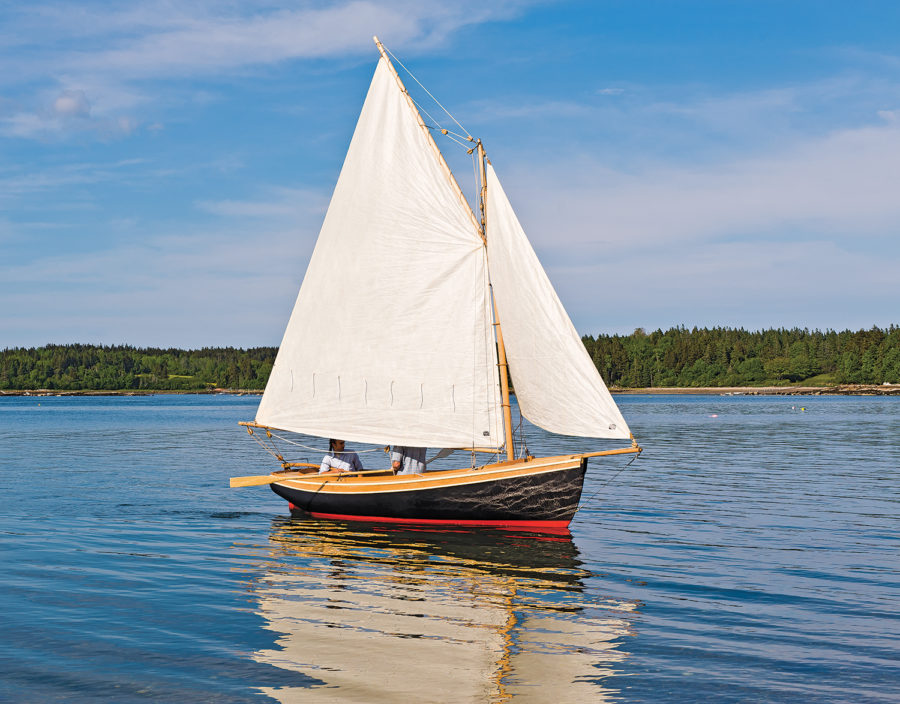
Hampton Sloop
Simplicity is the hallmark of this boat. All of the hardware is shop-made, and auxiliary propulsion is provided by a pair of ash oars.

Subscribe Today!
Become a subscriber today and you’ll recieve a new issue every month plus unlimited access to our full archive of backlogged issues.
Already a subscriber? Sign In
Subscribe For Full Access
Flipbooks are available to paid subscribers only. Subscribe now or log in for access.
Great choice! Your favorites are temporarily saved for this session. Sign in to save them permanently, access them on any device, and receive relevant alerts.
- Sailboat Guide
Melonseed is a 13 ′ 8 ″ / 4.2 m monohull sailboat designed by R. Crawford/Trad. and built by Crawford Boat Building (USA) starting in 1989.

- 2 / 17 San Antonio, TX, US 2003 Melonseed $8,000 USD View
- 3 / 17 San Antonio, TX, US 2003 Melonseed $8,000 USD View
- 4 / 17 San Antonio, TX, US 2003 Melonseed $8,000 USD View
- 5 / 17 San Antonio, TX, US 2003 Melonseed $8,000 USD View
- 6 / 17 San Antonio, TX, US 2003 Melonseed $8,000 USD View
- 7 / 17 San Antonio, TX, US 2003 Melonseed $8,000 USD View
- 8 / 17 San Antonio, TX, US 2003 Melonseed $8,000 USD View
- 9 / 17 San Antonio, TX, US 2003 Melonseed $8,000 USD View
- 10 / 17 San Antonio, TX, US 2003 Melonseed $8,000 USD View
- 11 / 17 San Antonio, TX, US 2003 Melonseed $8,000 USD View
- 12 / 17 San Antonio, TX, US 2003 Melonseed $8,000 USD View
- 13 / 17 San Antonio, TX, US 2003 Melonseed $8,000 USD View
- 14 / 17 San Antonio, TX, US 2003 Melonseed $8,000 USD View
- 15 / 17 San Antonio, TX, US 2003 Melonseed $8,000 USD View
- 16 / 17 San Antonio, TX, US 2003 Melonseed $8,000 USD View
- 17 / 17 San Antonio, TX, US 2003 Melonseed $8,000 USD View
Rig and Sails
Auxilary power, accomodations, calculations.
The theoretical maximum speed that a displacement hull can move efficiently through the water is determined by it's waterline length and displacement. It may be unable to reach this speed if the boat is underpowered or heavily loaded, though it may exceed this speed given enough power. Read more.
Classic hull speed formula:
Hull Speed = 1.34 x √LWL
Max Speed/Length ratio = 8.26 ÷ Displacement/Length ratio .311 Hull Speed = Max Speed/Length ratio x √LWL
Sail Area / Displacement Ratio
A measure of the power of the sails relative to the weight of the boat. The higher the number, the higher the performance, but the harder the boat will be to handle. This ratio is a "non-dimensional" value that facilitates comparisons between boats of different types and sizes. Read more.
SA/D = SA ÷ (D ÷ 64) 2/3
- SA : Sail area in square feet, derived by adding the mainsail area to 100% of the foretriangle area (the lateral area above the deck between the mast and the forestay).
- D : Displacement in pounds.
Ballast / Displacement Ratio
A measure of the stability of a boat's hull that suggests how well a monohull will stand up to its sails. The ballast displacement ratio indicates how much of the weight of a boat is placed for maximum stability against capsizing and is an indicator of stiffness and resistance to capsize.
Ballast / Displacement * 100
Displacement / Length Ratio
A measure of the weight of the boat relative to it's length at the waterline. The higher a boat’s D/L ratio, the more easily it will carry a load and the more comfortable its motion will be. The lower a boat's ratio is, the less power it takes to drive the boat to its nominal hull speed or beyond. Read more.
D/L = (D ÷ 2240) ÷ (0.01 x LWL)³
- D: Displacement of the boat in pounds.
- LWL: Waterline length in feet
Comfort Ratio
This ratio assess how quickly and abruptly a boat’s hull reacts to waves in a significant seaway, these being the elements of a boat’s motion most likely to cause seasickness. Read more.
Comfort ratio = D ÷ (.65 x (.7 LWL + .3 LOA) x Beam 1.33 )
- D: Displacement of the boat in pounds
- LOA: Length overall in feet
- Beam: Width of boat at the widest point in feet
Capsize Screening Formula
This formula attempts to indicate whether a given boat might be too wide and light to readily right itself after being overturned in extreme conditions. Read more.
CSV = Beam ÷ ³√(D / 64)
Crawford Boat Building P.O. Box 486 Humarock, MA 02047 781-837-3666 [email protected] www.melonseed.com
Embed this page on your own website by copying and pasting this code.

Discover Related Sailboats

United States Sailboat Show 2019
The sailboat show in Annapolis runs Oct 10—14, 2019, and features over 130 sailboats, including the premiere of 30 models over 30 feet.
- About Sailboat Guide
©2024 Sea Time Tech, LLC
This site is protected by reCAPTCHA and the Google Privacy Policy and Terms of Service apply.

Call Us: (253) 851-2126 Mon-Fri 9-5 Pacific Time
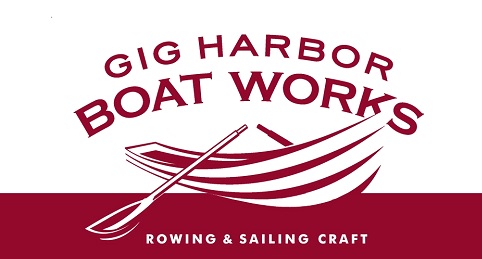
Melonseed Review in Small Craft Advisor Magazine
by GHBoats Webmaster | May 11, 2012 | Melonseed , Press Reviews
“Although she’s built with modern technologies for contemporary pursuits, the Gig Harbor Melonseed benefits plenty from some older ideas.”
In their March/April 2011 issue, Small Craft Advisor published a great feature on our 16′ Melonseed . They joined us for our first ever Melonseed Regatta where they could talk with owners about their experiences. The weather even cooperated with a beautiful clear day for a sail, and we always enjoy visiting with the folks from SCA!
The article discusses the origins of the melonseed design, and how we arrived at incorporating it into our own model line:
“Having received many requests for a boat that rowed as well as their 14-foot Whitehall but had more capacity, Dave and company began researching historical designs and landed on the melon seed. That the melon seed was a close relative of the Jersey beach skiff was encouraging, as Gig Harbor Boat Works had already successfully adapted that design with their 17-foot Jersey Skiff model. The Jersey skiff ’s workboat history and load carrying requirements called for significant freeboard, but for a better pure rowing boat Robertson knew he’d rather not have the windage, extra weight or steeper oar angle, so his Melonseedwas designed with a similar underbodybut one less plank at the sheer. While the sailing model (released in 2008) features the same hull, it is built with sealed decks, which effectively increase the boat’s freeboard. Rowing performance has never been an afterthought for Gig Harbor Boat Works, whose innovative rowing seat system has been used by trans-Atlantic rowing race winners and other highly regarded ocean-crossing rowers. The Melonseed features Gig Harbor’s unique system with eight large diameter wheels running on 16 stainless steel sealed ball bearings. The smooth, silent mechanism can be converted instantly to a fixed seat by dropping two stainless ball-lock pins into place. Gig Harbor also offers a clever and efficient forward facing rowing system.”
And of course, there are a few flattering quotes that make us blush!
On sailing performance:
“Whether in morning light zephyrs or the breezier conditions later, the Melonseed impressed us with its performance and responsiveness.” “…she offered exciting sailing right down next to the water, but she also felt stable and didn’t require exceptional athleticism to handle even during our races. In a word she was just like her rig: simple.” “The boat pointed well, never failed to come through a tack, and like most balanced lugs, jibed with equanimity.”
On rowing performance:
“Rowing performance was, as expected, excellent. All of the owners we communicated with seemed overwhelmingly satisfied with performance under oar.”
On trailering & launching:
“At a mere 195 pounds, the shallow draft Melonseed is as easy to trailer and launch as perhaps any boat we’ve reviewed.” “Rigging is also exceptionally easy.”
On seaworthiness:
“More stable initially than a typical dinghy at the same length, the Melonseed isn’t twitchy or overly sensitive to crew movement, and her pronounced sheer means her ends carry her up and over choppy seas.” “The sailing version of the Gig Harbor Melonseed scores a solid 125 on our SCA Seaworthiness Test.”
On quality:
“Gig Harbor boats can be ordered with lots of wood and other details or in more of a low-maintenance workboat finish, but in either case the quality and workmanship are excellent.”
“We think the Melonseed represents an excellent value. She’s quite versatile, being a pleasurable sailboat, an exceptional rowboat, and being small enough to manhandle but large enough to bring crew, the dog, or a few crab pots along.”
Aww gee, shucks! Many thanks for the kind words, guys!
The full article includes a lot more photos as well as quotes from Melonseed owners. You can purchase a hard copy of the full issue from SCA here , or download a PDF of the full review here .
Newest Posts
- Annapolis Sailboat Show Oct 10-14, 2024
- Small Boat Festival at Port Ludlow – July 27th
- Lobster Boat Update #3: Preorders Now Open!
- “Pale Valley” Salish Voyager Finishes Strong in Seventy48
- See You at Anacortes Boat & Yacht Show, May 16-18!
- Beach Dolly (1)
- Best of GHBoats (5)
- Customer Questions (8)
- Customization (1)
- Galleries (4)
- Maintenance and Repairs (3)
- Announcements (13)
- Boat Shows (15)
- Just for Fun (17)
- Mailbag (44)
- Newsletters (25)
- Ocean Rowing (13)
- Press Reviews (10)
- Now Hiring (1)
- Woodwork (3)
- Captain's Gig (2)
- Jersey Skiff (4)
- Lobster Boat (5)
- Melonseed (6)
- Navigator (4)
- Nisqually (2)
- Point Defiance (7)
- Salish Voyager (18)
- Swampscott Dory (1)
- Whitehall (7)
- Sea Stories (13)
- Site Guide (4)
Blog Archives
Site search.

- Plans & Kits
- Plans by designer
- Paul Fisher
- GP Dinghies over 13'
16' Selway Fisher Melonseed Skiff Plans

- Create New Wish List
Description
|
| ||
|
| ||
Related Products

13'4" Selway Fisher Melonseed Skiff Plans

16' Fisher Swampscott Plans
16' iona skiff plans.

16' Islay Skiff Plans

Light Melonseed Plans PDF
| |||||||||||

IMAGES
COMMENTS
Learn about the Melonseed Skiff, a beautiful and versatile reproduction of a nineteenth century American workboat, built by Crawford Boat Building. See videos, photos, reviews and contact information of this fine craftsmanship boatshop.
The Melonseed's construction is world class. These boats are truly beautiful! The fiberglass hull and deck is superbly and honestly built by hand layup and elegantly adorned with rich teak woodwork and fine bronze hardware. At Crawford Boat Building we've created more than just beautiful boats. Since 1976 we've built a reputation for quality ...
Yes, the melonseed's shoal draft, likable sailing characteristics, and casual trailerability all contribute to the continued popularity of this 19th-century design. But some of us are convinced that it survives primarily because it is a beautiful boat…well worth building, even if we're not inclined to blast unfortunate ducks out of the sky.
Melonseed Construction Months before construction of the Melonseed skiff ever began we were test sailing a prototype/test boat. Early evaluations of its performance revealed that the Melonseed was capable of sailing in more wind and rougher water than we anticipated.
The Melonseed is a historical design from the Chesapeake Bay, derived from the famous Jersey Beach Skiff, but suited for rowing on more sheltered waters. The Jersey version, being a heritage workboat from the more exposed Jersey Shore, has a higher freeboard for dryness under sail and greater load carrying capacity. However, a pure rowing boat is hindered by that high freeboard due to ...
Crawford Boat Building's Melonseed Skiff fit the bill.For over 30 years, Roger Crawford has been building his fiberglass version of the Melonseed Skiff in his small shop in Humarock, Massachusetts. He began when a decaying wooden boat, built to Chapelle's lines in American Small Sailing Craft, was dropped off at his shop to be brought back ...
Melonseed is a 13′ 8″ / 4.2 m monohull sailboat designed by R. Crawford/Trad. and built by Crawford Boat Building (USA) starting in 1989.
The Melonseed is a skiff you can sail or row. The builder increased the sail area by 25 square feet to improve performance. The Melonseed loves a good breeze. I'll tell you what makes this boat special. It is as shapely a little hooker as you will find anywhere. From its hollow entry to its almost heart-shaped transom, this boat is a symphony ...
Learn about the MELONSEED, a centerboard dinghy with sprit/lug rig, designed by R. Crawford and built by Crawford Boat Building. See sailboat specifications, calculations, links, and forum topics.
www.melonseed.comThe Melonseed Skiff is an extraordinarily beautiful reproduction of a nineteenth century American workboat, that has reemerged a century lat...
This video is about sailing the ultimate recreational dinghy ... the Melonseed Skiff.Learn more about the excellent rowing and sailing Melonseed Skiff by Rog...
14.5' Crawford Boat Building Melonseed Skiff sailboat for sale in Alexandria Virginia
The MELONSEED was originally a sailing and hunting boat developed in the New Jersey Bay and Delaware River areas. The design was intended to be more of an open water boat, drier, and more seaworthy than similar boats of that era.
The Melonseed features Gig Harbor's unique system with eight large diameter wheels running on 16 stainless steel sealed ball bearings. The smooth, silent mechanism can be converted instantly to a fixed seat by dropping two stainless ball-lock pins into place. Gig Harbor also offers a clever and efficient forward facing rowing system.".
Florida. $7,000. Description: Crawford Melonseed skiff built 2003 in almost new condition. this is the centerboard model with draft from 6" to 30" with galvanized trailer in excellent condition. Equipment: complete with all rigging, the sail, the oars and a couple of folding seats and 2 boat covers for traveling. Location: brooksville, Florida.
Brush Creek Yachts builds and restores wooden boats in North Carolina and Virginia Mid-Atlantic region. Specializing in Melonseed Skiffs and other small craft.
The original Melonseed skiffs were gunning boats for hunting around the New Jersey area of North America. Unlike some of the other gunning skiffs and sneak boxes which were definitely inland boats, the Melonseeds were for use in more open and estuary waters which, around New Jersey, could be quite choppy.
Crawford Melonseed preowned sailboats for sale by owner. Crawford Melonseed used sailboats for sale by owner.
The Remarkable Melonseed Skiff Melonseed: The Story Rigging and Sailing Tips Melonseed Construction Specifications and Cost Heavy Weather Sailing Slide Show
Melonseed preowned sailboats for sale by owner. Melonseed used sailboats for sale by owner.
The melonseed sail, rigging and other components can be easily maintained or replaced with original parts. Because of this enduring quality Crawford Boat Building melonseed skiffs retain their value, and we are proud to present our melonseed skiff along with small craft by other boat builders currently for sale by their owners .
Buy used Melonseed skiff. DailyBoats.com lists used Melonseed skiff for sale , with prices ranging from $6,200 for the more basic models to $6,200 for the most expensive. These yachts come in various sizes, ranging from 12.99 ft to 12.99 ft, with the oldest yacht built in 1996. This page features boats located in United States of America.
Melonseed preowned sailboats for sale by owner. Melonseed used sailboats for sale by owner.